Ski the Last Degree: South Pole
2010 South Pole “Ski the Last Degree” Expedition Trip Report
Introduction
In January of 2010, I was a member of a Ski the Last Degree Expedition to the geographical South Pole. What’s the “Last Degree?” It is simply one degree of latitude. The South Pole is located at 90 Degrees South Latitude. In a Last Degree Expedition the object is to ski from 89 Degrees South to 90 Degrees South, a distance of sixty nautical miles.
…there are few places on earth as desolate, unforgiving and silent as the great ice desert of the polar plateau.
There are few places on earth as desolate, unforgiving and silent as the great ice desert of the polar plateau. As you trudge over the ice (it is too cold for the skis to have any glide whatever) you know that you are in a place where men were never meant to be. It is wonderful to be able to visit a place so far outside ordinary experience.
Prior to going to Antarctica I was surprised at how little information was available chronicling Last Degree attempts on the South Pole. I have tried to make my trip report as thorough as possible to capture the true flavor of the experience. In a lifetime of travel this trip stands out as absolutely unique.
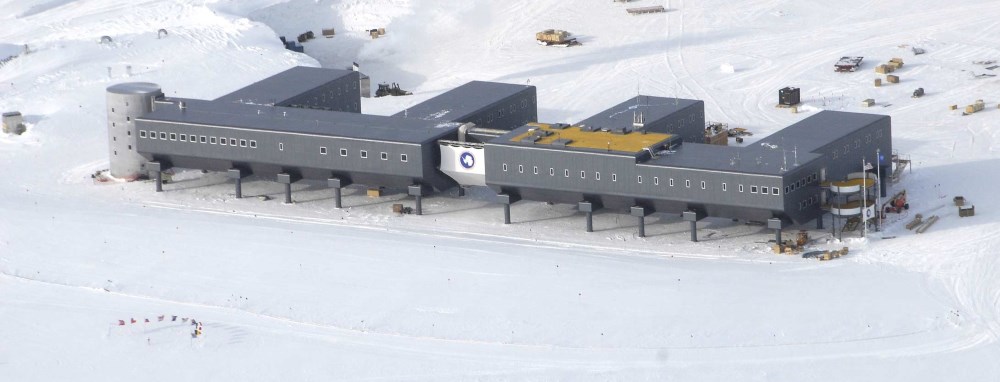
Beginnings
I never really knew much about Antarctica until three years ago when I read Apsley Cherry-Garrard’s classic, The Worst Journey in the World. It was fortuitous that my polar education started with the best book about Antarctic exploration ever written. After seeing the harrowing events of Robert Falcon Scott’s 1910-1912 Terra Nova expedition through Cherry-Garrard’s eyes, Antarctica became a place of fascination for me. The grand scale of suffering endured by the explorers of the “heroic age” was beyond anything I had ever encountered. I have read a lot of mountaineering literature, and tales of hardship and endurance against all odds are familiar features of that genre. However, in mountaineering epics if nature turns nasty you either win out or die in a matter of days. In Antarctica you die by inches of starvation, scurvy or exposure over a period of months. Hard, hard months. The bravery, perseverance and commitment of men like Scott, Shackleton, Amundsen and Mawson (collectively, the “big four” of Antarctic exploration) is scarcely comprehensible to those like me with easy modern lives whose every day is swaddled in creature comforts.
After reading dozens of books about the early quest for the Pole, others about more recent but scarcely less horrifying journeys and, in a markedly lighter vein, internet blogs about the curious culture that exists at the big permanent bases on Antarctica today, I decided that I had to go there myself. Not having the time (sixty days/690 miles) or inclination for an all-the-way ski trek to the Pole from Hercules Inlet, I settled on the “Ski the Last Degree” option covering sixty-nine miles (sixty nautical miles / one geographic degree of latitude) in eight days. While it is possible to book a trip that involves no skiing at all, I wanted my polar experience to be at ground level. I wanted to haul a sledge and in some tiny way relive the days and nights of the pioneers as they approached the Pole nearly one hundred years ago.
Getting to Antarctica is simple. During the Austral summer Adventure Network International (ANI) runs regularly scheduled all-inclusive trips to the continent. All you have to do is sign on and write a big check.

What follows is a diary of my trip there and back.
Friday and Saturday, January 1-2
Going to Antarctica entails taking a lot of gear and spending a fair amount of time on airplanes. Even though skis, skins, poles and sledges are provided, I was startled at how much stuff I had once the sleeping pads, down gear and boots went into my kit. A big expedition duffel bag is a must when traveling to the continent.
…Punta Arenas is a seaport on the famously blustery Straits of Magellan.
ANI’s trips to Antarctica depart from Punta Arenas, Chile. Punta Arenas is near the southernmost tip of South America just opposite Tierra del Fuego Island. It is a seaport on the famously blustery Straits of Magellan. Getting there is not entirely straightforward. For me it started with a two-hour flight from Houston to Miami followed by an overnight flight to Santiago, Chile. The night flight proved to be excellent training for Antarctica since LAN (the national air carrier for Chile and some other South American states) keeps its planes notoriously cold. A long layover at Santiago was eventually rewarded with a scenic four hour flight down the backbone of the Andes and over the ferociously difficult Patagonian peaks, Cerro Torre and Fitzroy.
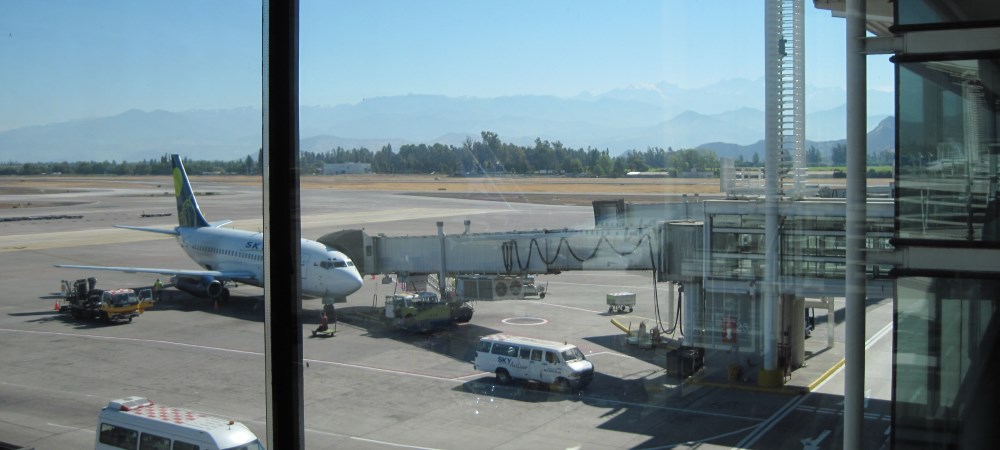
The plane touched down at Punta Arenas Saturday evening following an approach that revealed a stark and uninviting landscape. The bushes at the airport fringe were inclined away from the wind at impossibly steep angles. There was no doubt about the prevailing wind direction here. After collecting my luggage I hired a cab and was installed in my hotel twenty-five minutes and 8,000 Pesos (about $16.00) later. The Los Navegantes Hotel was scruffy but the wireless internet and television both worked. It would do just fine.
Sunday, January 3
It is always a pleasure to wake up in a strange city and sample the local cuisine. The breakfast offerings at the hotel were simple but the coffee good and plentiful. The only item on the agenda for the morning was to attend an ANI orientation meeting at 10 am.
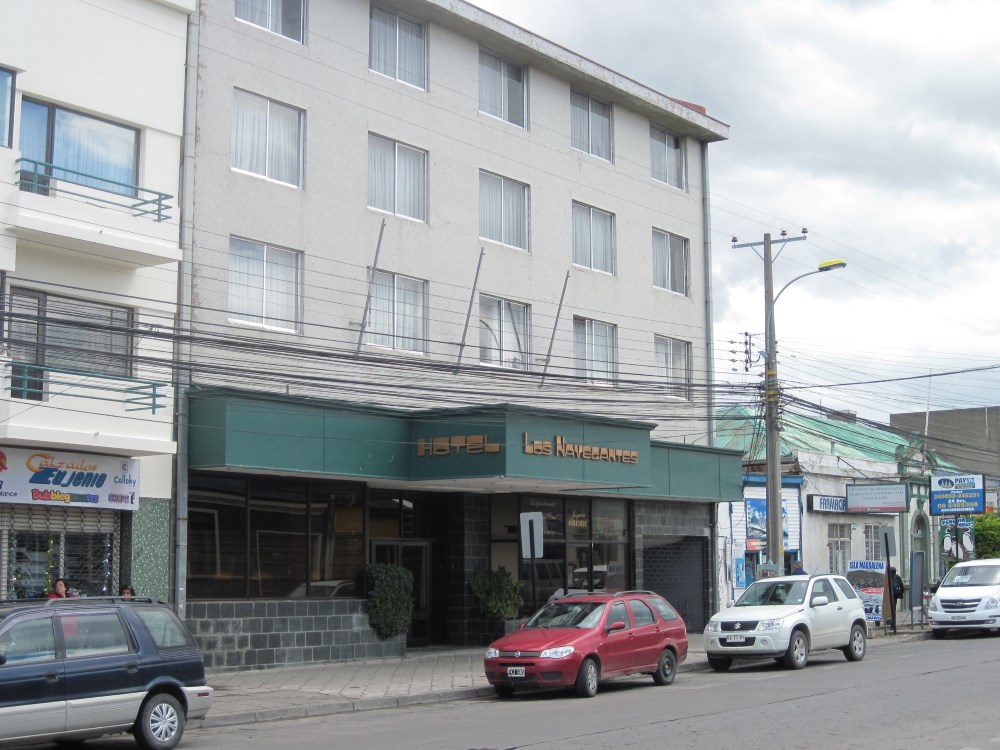
The briefing was hosted by an ANI staffer who was on sabbatical from his base camp manager job at Patriot Hills. Per him, this year will be the last one for Patriot Hills, the ANI nerve-center about 690 miles distant from the geographic Pole. The natural blue ice runway at Patriot Hills has been the debarkation point for Antarctic expeditions since 1985 and it was surprising to hear of its imminent closing. Evidently, the big disadvantage of the site is that the ice runway is swept clear by a crosswind from the adjacent mountains. This eases runway maintenance issues but makes landings extremely weather dependent. The new base will have the runway oriented into the wind and that will make the weather a much less critical factor than it is currently. Everyone traveling to Antarctica now is explicitly cautioned to expect protracted weather delays and this doubtless discourages many from considering the trip. If the new scheme works as planned it will open up a new era in travel to the continent.
…Somehow, in modern usage it has become incorrect to say “the Pole,” at least among people who have actually been there.
At the meeting, which was an hour-long slide show aimed at all varieties of polar travelers, I learned that another guy, Lars, had been added to the Last Degree crew. I met him and the father and son team (Stephan and Patrick) that I’d previously heard was coming. In addition to us there was one Vinson Massif climber and five all-the-way flyers on this trip. Per the ANI presenter, the all-the-way flyers will go to Pole in a Basler (a heavily modified DC-3). The Basler has greater range than the more commonly used Twin Otter and can do the round trip to Pole without a refueling stop. “Pole,” by the way, is the accepted way of referring to it. Somehow, in modern usage it has become incorrect to say “the Pole,” at least among people who have actually been there.
Right after the meeting I went back to the hotel with an ALE-staffer, Hannah, for a gear-check. Hannah just completed guiding a 38-day all-the-way trip to Pole from the Messner starting point. The Messner start saves about one hundred-forty miles versus the Hercules Inlet route. She has done three other all-the-ways, including a solo. She is a tall and admirably fit-looking young woman.
She emphasized the need to stay dry (no sweating allowed!) and said that the biggest problem is being too warm, not too cold. She predicted that I’d seldom need the extreme cold weather gear included in my kit. Most surprisingly, she said that I would probably find that light fleece gloves will be fine while on the road because the poles ANI provides have built-in insulated covers (“pogies”).
After lunch ANI picked up my duffel bag so that it could be loaded onto the plane. I then ventured out in a light rain to take a look at Punta Arenas. It is a nice town, clean and orderly. I’d read that at one time Punta was one of the most important seaports in the world. Then they built the Panama Canal and things have not been quite the same ever since. Nonetheless, there are lots of shops and one gets the impression of solid middle class prosperity. Upon returning to the hotel a couple of hours later, I lazed about and enjoyed being far away from deadlines and ringing phones. It was nice to be on vacation!
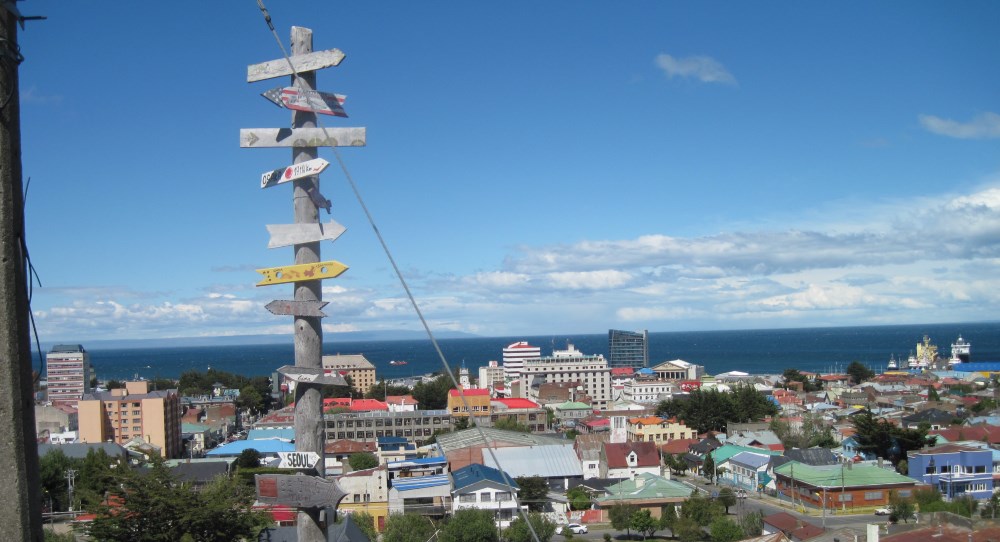
In the early evening, the weather brightened and I went out for another walk. I hiked down to the town square (Plaza de Armas) and visited the monument to Magellan there. It is an impressive affair with a larger-than-life statue of the great explorer standing atop a twenty foot high stone column. A large bronze Indian sits on one side of the column and local legend has it that touching the Indian’s toe assures a traveler’s safe return. The toe was burnished to a high luster by thousands of fingers so there must be something to the legend. Not wanting to tempt fate, I added my own good-luck tap.
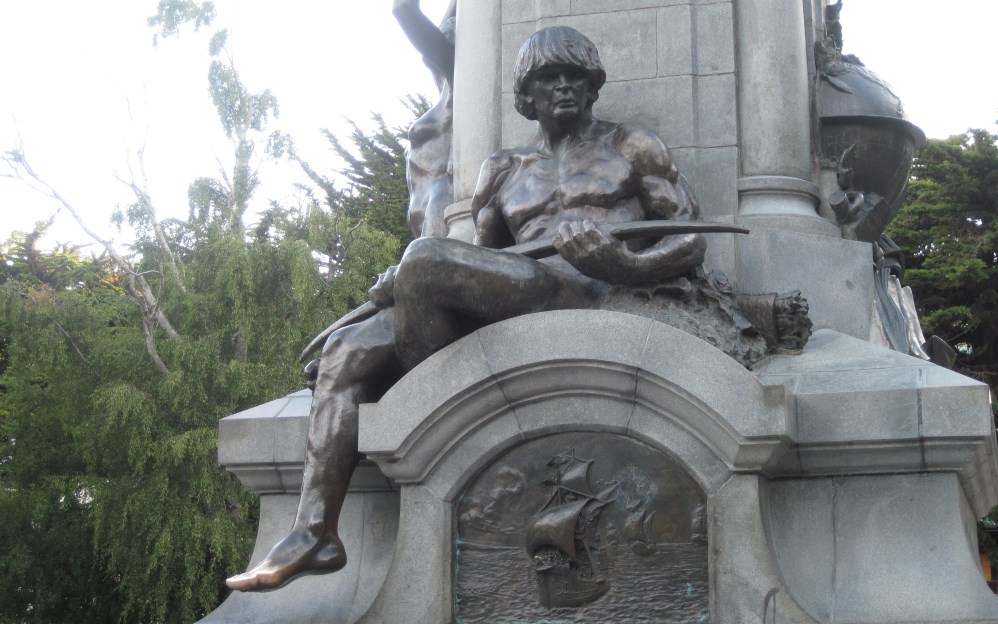
Monday, January 4
I woke at dawn and was hoping for an early saddle-up call from ANI but no luck. Sometime later an ANI staffer called to say that the flight was on hold due to cloudy conditions at Patriot Hills. On the good side, winds there were light. He said that he would call at 11 am with an update. So, with two hours to play with I ventured out and walked down to the town cemetery, one of the few tourist attractions Punta Arenas has on offer.
…sightseeing in Punta Arenas involves going to the cemetery!
It was a fascinating place filled with elaborate mausoleums, five-high stacks of egg-crate crypts and wonderful topiary trees. Local custom evidently encourages placing pictures of the deceased on the headstones and there were lots of these. Many of the headstones had glazed windows fronting niches where photos and knick-knacks could be displayed and periodically refreshed. It was strangely enthralling to gaze upon those faces and imagine them going about their lives in this austere town years and years ago. There is a poignancy about places inhabited by the dead and a strong sense of the cycle of life. It was marvelous how the pictures on the graves lifted these long-gone people from anonymity and let the looker imagine the lives they led. It was curious too the pictures families chose to represent them in life. A great many were simple snapshots taken with obvious informality at family gatherings or places visited. One can imagine family members thumbing through old albums and rediscovering photos where Mom wore an expression that was characteristic of her or which evoked memories of a happy event. It was wonderful to time-travel into these pictures and imagine how it was for the deceased on that day.
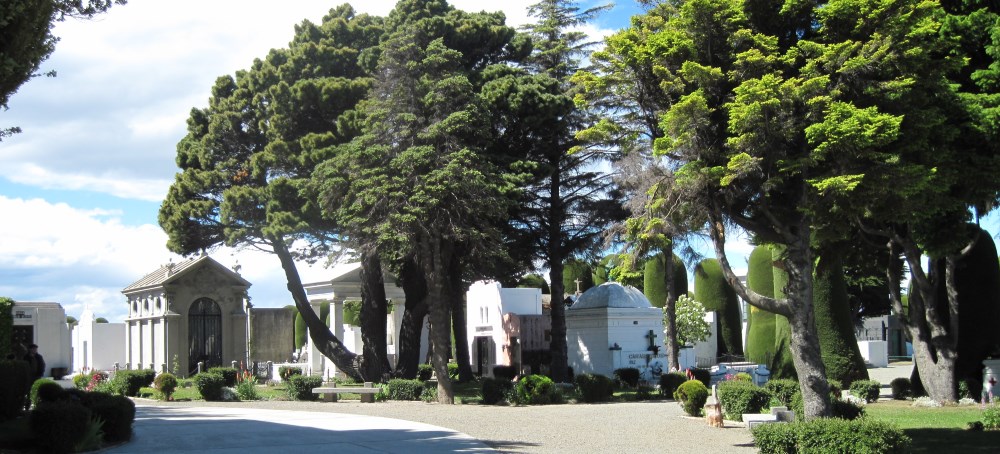
Cemeteries are, of course, doleful places and mostly I think from displays of living persons’ dedication to the dead. While walking down the path separating one row of graves from the next my attention was arrested by an odd musical note. It was from an electronic Christmas card stapled to a stake next to a headstone. The card was arranged so that it would open when the wind blew and play a carol for the deceased; a modern prayer wheel whose battery was failing and musical voice slowing and deepening. It was melancholy to imagine the card sending its song into empty days and cold nights since before Christmas. Surely the person who put it there regarded it as a nice devotion and remembered Christmases celebrated together.
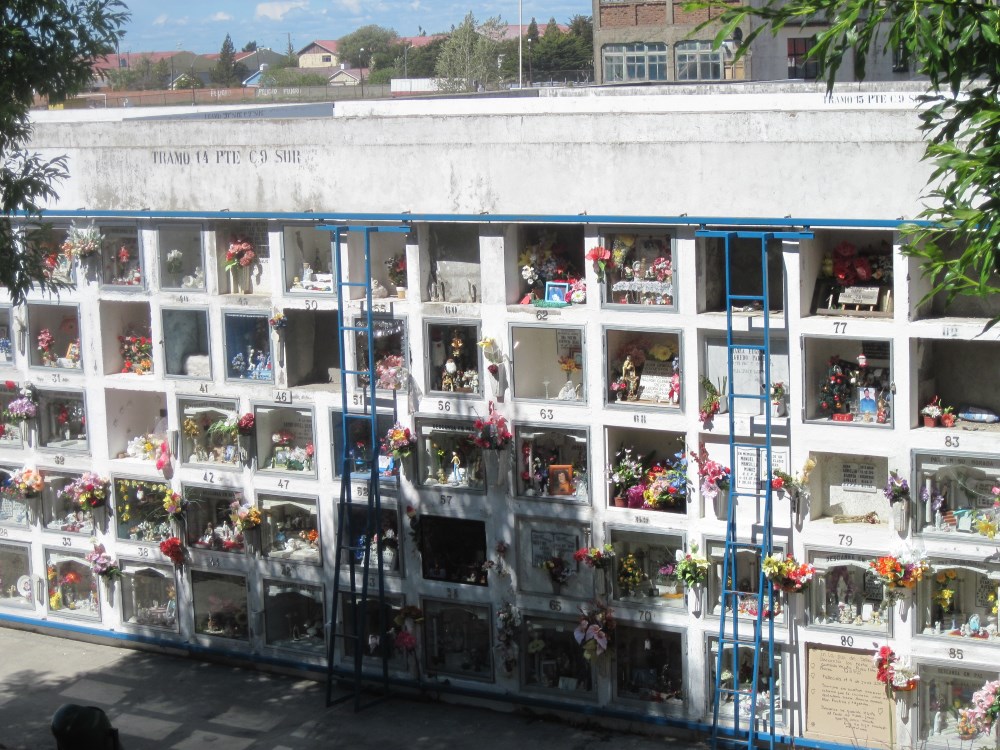
After this reflective time in the cemetery I hustled back to the hotel for the 11 am status check. ANI called and reported no change. They requested that I be available for a 2 pm update. At 2 pm there was still no change, next update at 7 pm. When the 7 pm call came the word was “no flight today”.
Tuesday, January 5
The morning call brought word of slightly improved conditions at Patriot Hills. At noon it was the same story but at 5:30 pm we got the “go” signal and I was picked up half an hour later by a big bus. The others were collected at various other hotels and in short order we were on the way to the airport. Once there we whisked through security and were quickly led to the Ilyushin Il-76. The Ilyushin is an absolutely beautiful Soviet era military aircraft. Inside, there were four rows of three seats on each side of the aisle and a big cargo bay behind. The plane’s interior was strictly utilitarian and clearly well worn-in (someone said that the plane was first commissioned in 1991). There were no frills of any sort and only four porthole windows, mounted too high to see anything out of while seated. Beyond a forward bulkhead you could glimpse the plane’s plexiglas nose and the sky beyond. The pilots sat in a compartment a level above us. One flight crew member sat in our cabin in front of an array of gauges and dials. There’s no telling what his function was because he napped most of the flight. We were all given earplugs before takeoff. We needed them.
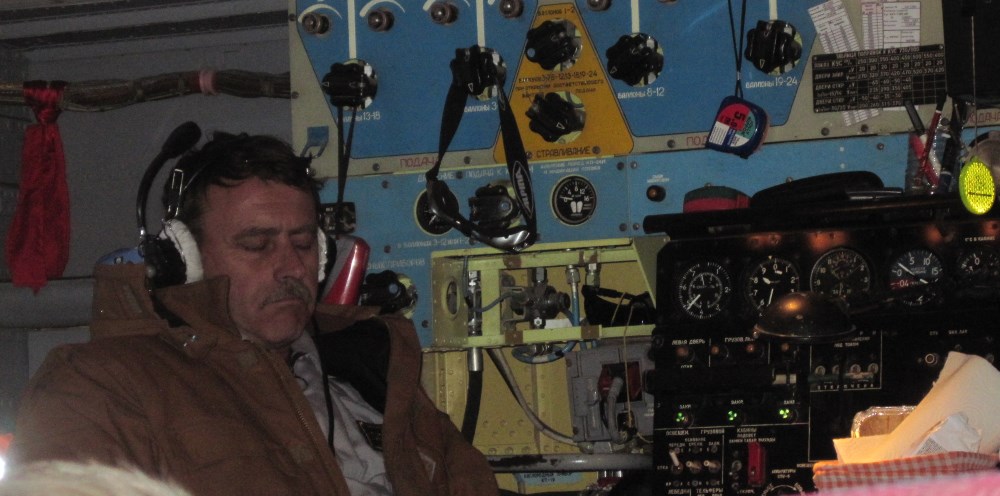
The plane was launched within minutes of boarding. Takeoff was curiously un-dramatic. Since you could not see anything, you had no sense of flight at all. We might as well have been in a railroad boxcar.
In agreeable contrast to LAN, the Russians kept the cabin delightfully warm. We were given a sandwich, chips and a chocolate bar and these provided a pleasant diversion. Munching on my sandwich, I kept an eye on the framed icon of the Blessed Mother (!) attached to a bulkhead above the flight engineer’s control panel. I confess it hardly seemed possible that we were actually headed for Antarctica. I had mentally prepared myself for a lengthy delay in Punta Arenas and it seemed miraculously fortuitous that we were actually going there now. There was cloud cover for most of the flight but about forty minutes before landing I got a view of some far-off mountains.
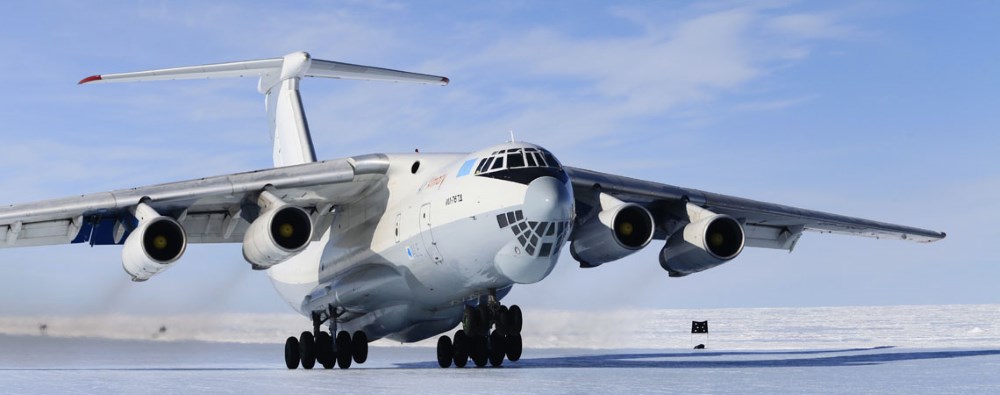
Landing was smooth but incredibly noisy. All braking is done with reverse thrust and that creates a lot of commotion. In any event, at 12:15 am, four hours and twenty minutes after takeoff, we were here. In this land of 24-hour sunshine, it was as bright as day outside and there was no sense of having arrived at night.
…Antarctica is an other-worldly place and the view from Patriot Hills camp is beautiful.
Antarctica is an other-worldly place and the view from Patriot Hills camp is beautiful. You are immediately confronted with a flat icy vastness on one side and rugged rock-and-ice mountains on the other. Happily, conditions were mild with temperatures in the high teens. I was perfectly comfortable walking the three-quarter mile distance to the base in light hiking shoes and a couple of layers of fleece.
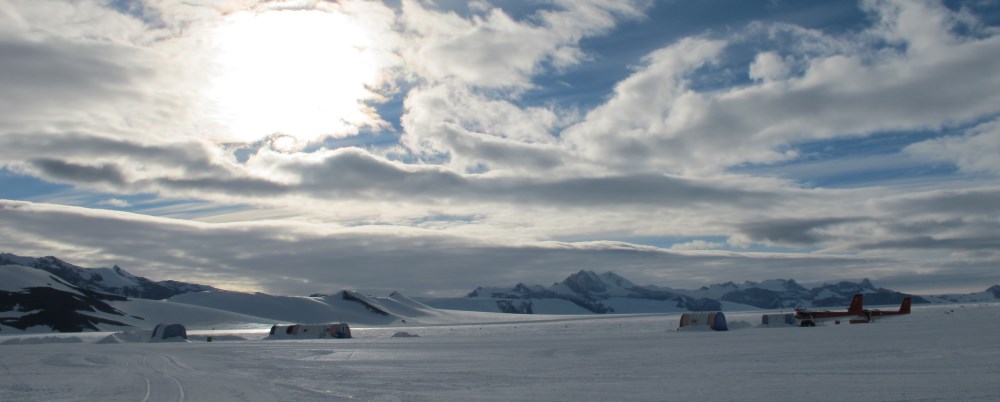
We went directly to the dining tent (a big Quonset-type hut) for a hearty welcoming dinner. Rob, our guide, introduced himself and proposed that tomorrow we meet after breakfast, draw equipment and do some practicing. He said that on Thursday we would do an overnight shakedown trek. Thereafter, we’d leave for Pole at first opportunity. After dinner we checked tent assignments (I’m bunking with Lars, the young Norwegian guy) and had the wonderful surprise of seeing how comfortable the “clamshell” tents are.
The clamshells are large, about 12 feet by 8 feet by 7 feet tall, aluminum framed with a canvas-covered plywood floor. You lay your sleeping bag down on a lovely twin mattress and you are good to go. Very civilized!
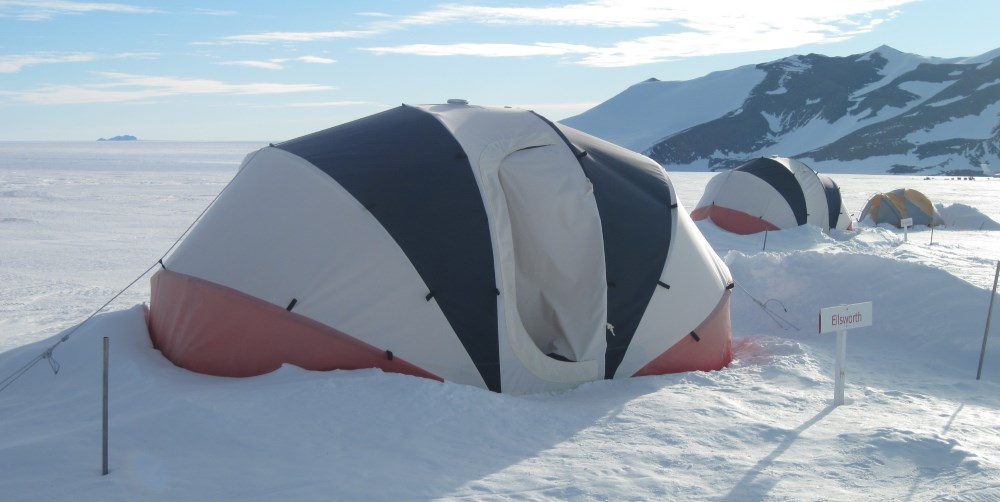
It was as bright as can be in the tent. I wished I had brought my eye-mask along.
Wednesday, January 6
It was fun to start to get acquainted with folks over breakfast. We met with Rob and afterward went down to the “hangar” (an equipment shed mostly drifted over by snow) to draw gear. The skis were narrow cross-country models and three of us had to go to the workshop after lunch to have our huge Baffin boots ground down to fit the bindings. We went out for a one-hour ski to try things out. For me, the trial went poorly. The skis-boots-bindings combination was not good. My left boot continually rolled outward and even over groomed ground I had difficulty.
I was more than a little chagrined about my equipment problem, particularly since none of the others had any complaints at all. One of the ANI staffers promised to modify a pair of backcountry skis to see whether that ski-boot combination would work better for me. With our overnight shake-down journey scheduled for the next day I was in urgent need of a fix.
The crew I’m with is gigantically experienced. Lars is a Norwegian who grew up on skis and Patrick and Stephan are Swiss who do extreme cold weather events every year. Lars, Stephan and Patrick have all done the North Pole Last Degree trip. Interestingly, Patrick and Stephan have extensive dog sledding experience including the European equivalent of the Iditarod. All three guys are effortlessly comfortable on the ice. Very impressive.
The rundown on the team is as follows:
Lars: age 33, a fit and experienced adventurer. He is co-founder and Chief Technical Officer of an Oslo-based internet service provider. He is an enthusiastic traveler who has been almost everywhere.
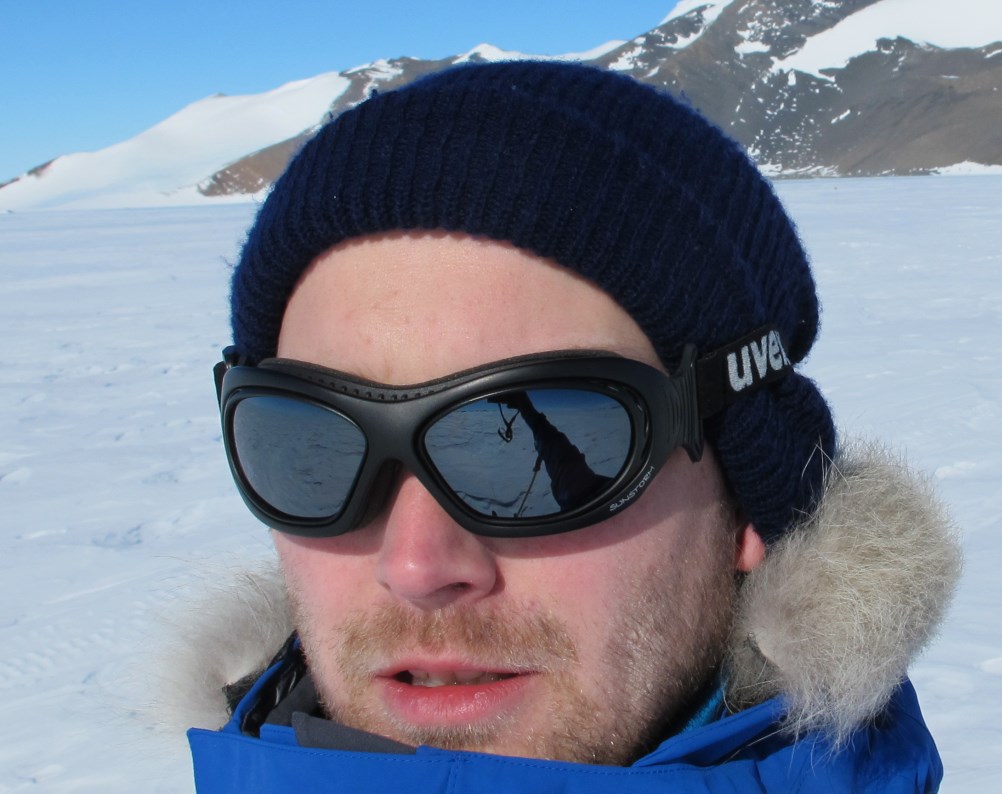
Stephan: age 60, a Swiss-American dual citizen and former Swiss Army Mountain Division member. He is patriarch of a successful family business that has branches throughout the Middle East, Africa and Japan. He travels tirelessly and has homes in Florida and Montana.
Patrick: age 29, a Swiss-American dual citizen and hard-working participant in the family business. He travels even more than his father and goes to places in Africa and the Middle East that nobody in his right mind would go to unless impelled by a strong profit motive. When not traveling, he splits his time between Montana and Dubai.
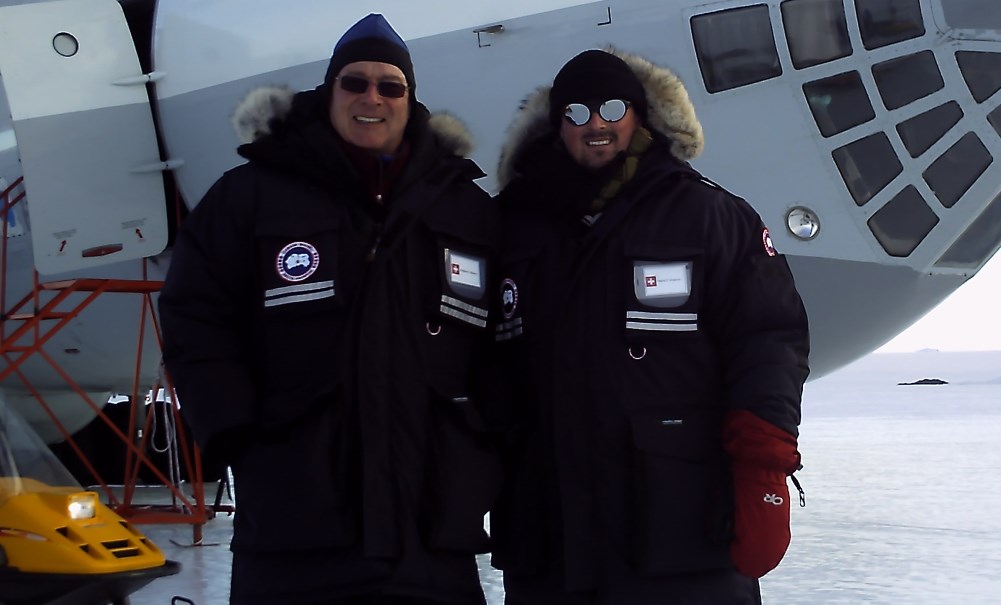
Our guide, Rob, is a capable, confidence-inspiring guy with a very pleasant way about him. He is a Brit, age 35, and this will be his first trip to Pole. Here he guides Vinson and when not in Antarctica guides in Scotland and the Alps. He is an accredited IFMGA Mountain Guide and as such is in the top rank of his profession. He has lots of Antarctic experience, having done a couple of years on the peninsula with the British Antarctic Survey. He has his own website and guiding business.

As for me (Tom), I’m 61 years old and live in the great snow sports Mecca of Houston, Texas. I am co-owner of an energy and real estate development merchant bank. I’ve done a bit of climbing all over the world.

The weather here has been shockingly warm. I don’t think it has been much lower than the teens. While skiing and walking around I have been comfortable in a base layer and down vest. When we woke up this morning, Lars reported that it was above 60°F in the tent. I cannot say enough about how nice the clamshell tent is. It is roomy enough for six people so having just two in it is fabulous. An added bonus is that we will have the tent for the duration of the trip and can leave excess personal gear right there.
Thursday, January 7
First thing this morning I went down to the hangar to try the newly-modified backcountry skis. To my infinite relief, the new Karhu skis worked great. They are shorter and fatter than the old ones and the bindings and boots matched up much better. After the first five minutes I was sure they’d be a winner. As I went off to bed last night I was terrified at the prospect of having to wear the big 195cm narrow skis because I did not think that any amount of tinkering would allow the skis-and-boots combination to work well for me. I knew that my left ankle could not possibly endure sixty-nine miles of rolling outward with every step. Now, problem solved! However, if I ever come to Antarctica again for a sledging journey I will definitely plan on bringing my own skis and boots.
Interestingly, Patrick has also chosen to use the fat Karhu skis. Everyone else is riding the more traditional narrow skis. Lars’s rig is unique in that he is using conventional 75mm Nordic boots rather than the ungainly minus 80°F-rated Baffins that ANI recommends. There is no doubt that his set-up is the most efficient of the lot. Lars has tested his boots in very cold conditions and is completely confident that they will keep him warm. Lars is far-and-away our best skier so I have no doubt that he will be just fine.
…I later learned that the boots Lars was using were Alfa Mordre Pros, the number one choice for all modern day explorers.
We stuffed our sleds with camping gear, food and fuel and after lunch set off on our overnight training/shakedown trek. Our sleds were light with none of us pulling more than 75 pounds or so. We traveled on the Antarctic Marathon circuit around the Patriot Hills. It was beautifully warm (20°F) and only occasionally windy. The skis glided well and the sleds pulled without any difficulty. With each step I gained more confidence in the Karhu skis and my ability to use them.
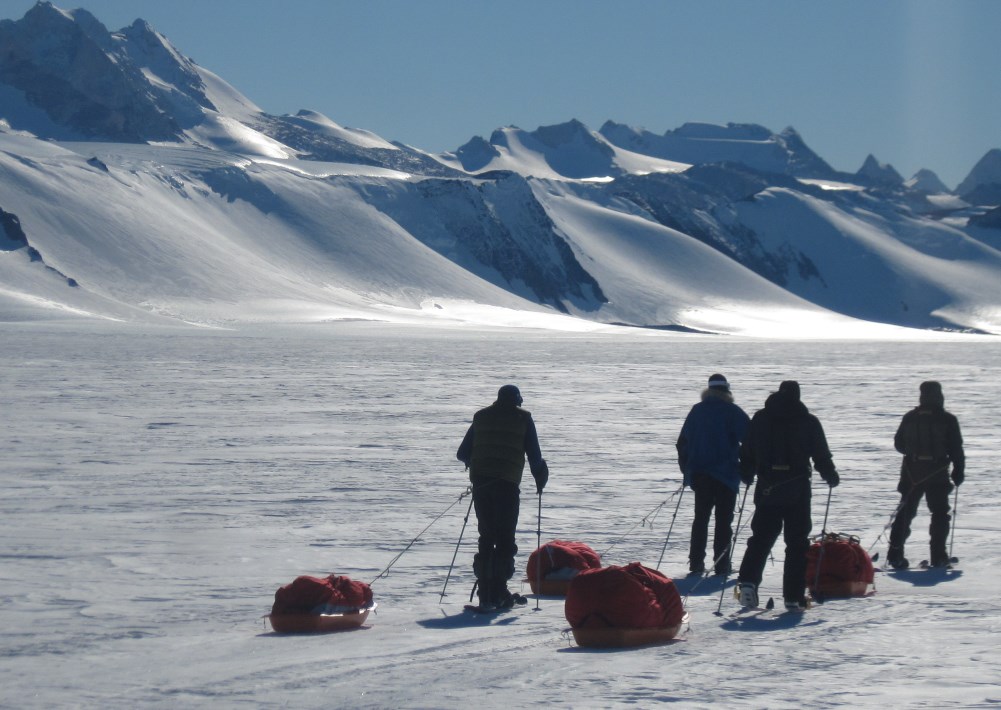
We went about two thirds of the way around the twenty-five kilometer marathon circuit. Along the way we spotted a skua. What it was doing hundreds of miles from open water and any possible source of food is a mystery. Lost? He certainly looked healthy and after briefly examining us flew on showing no sign of distress. Later we learned that he visited Patriot Hills camp where he created a sensation. Unimpressed with people he soon departed, destination unknown.
During our outing we stayed mostly on the semi-groomed trail but also tested the natural snow. Our pace was excellent, we were on the move for five hours and forty minutes and no one appeared to be working hard. I’m sure that this was a function of the perfect conditions, light sleds and low altitude but I was thrilled that it was such an encouraging performance. Tomorrow we will finish the circuit and, per the plan radioed in after dinner, will leave for Pole in the Otter in two days (Saturday). We will hope to arrive back at Patriot Hills base by noon tomorrow, resupply and get ready to go. The plan that had been bruited earlier had us going to Pole with the all-the-way-flyers in the Basler. I am glad that we will do it by ourselves in the Otter.
While on the trail I’m sharing a tent with Lars and Rob. Patrick and Stephan are in the second tent. Rob handled all the cooking for us and the others handled their own domestic needs. I’m not much of a cook so this is a great deal for Lars and me.
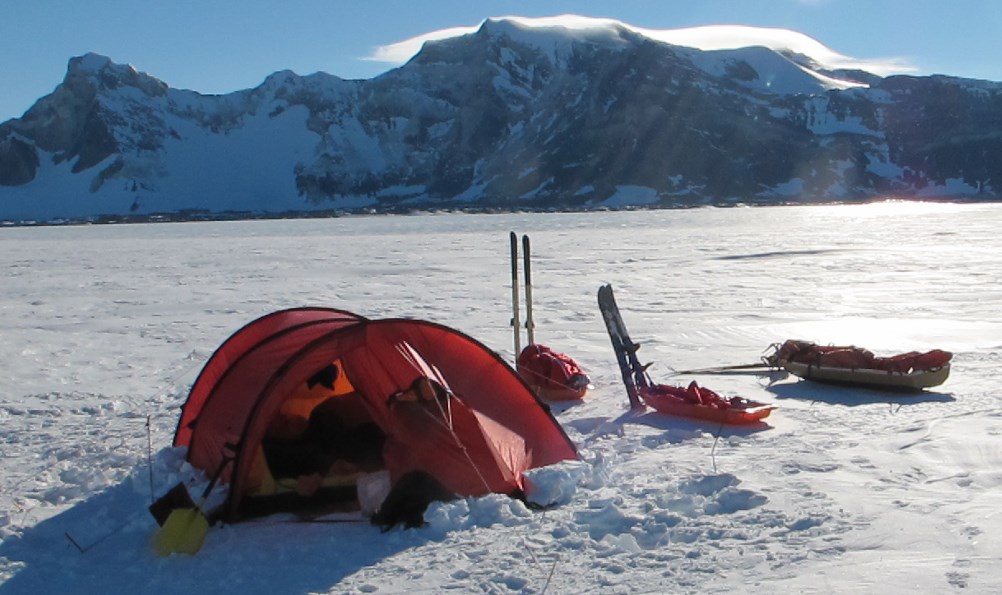
Friday, January 8
We completed the marathon circuit this morning in two hours and forty minutes, arriving at camp about 11am. We slept in late, had a quick breakfast and then broke camp. It only took thirty minutes to break camp and get underway. Once again, the weather was glorious, sunny and in the 20°sF. The trek was uneventful. It was wonderful to get back into camp and to hang out over coffee and lunch in the dining tent. The food here is great. They even bake fresh bread every day and it is clear that the kitchen crew is hard-working and talented.
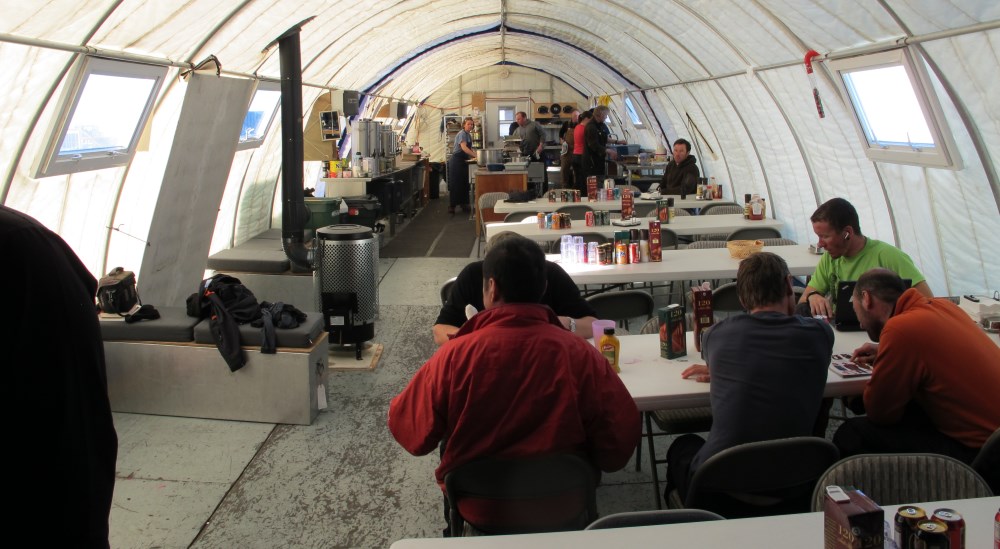
After lunch we sorted personal gear and had a cautionary lecture by the camp doctor about cold injuries and the need to stay completely covered. There were lots of grisly pictures showing blackened digits and a particularly notable one of a Last Degree skier’s nastily nipped thighs.
Afterwards, we repaired to the Ice Cave to draw rations. The Ice Cave is exactly what its name implies. It is at a constant minus 4°F (minus 20°C) and is cheerfully lit with strings of miniature Christmas tree lights. We then went to the hangar, cataloged the food, put it into bags and hauled everything up to the sleds so that they would be ready to go in the morning. Our flight to 89°South latitude will go, weather allowing, after breakfast tomorrow.
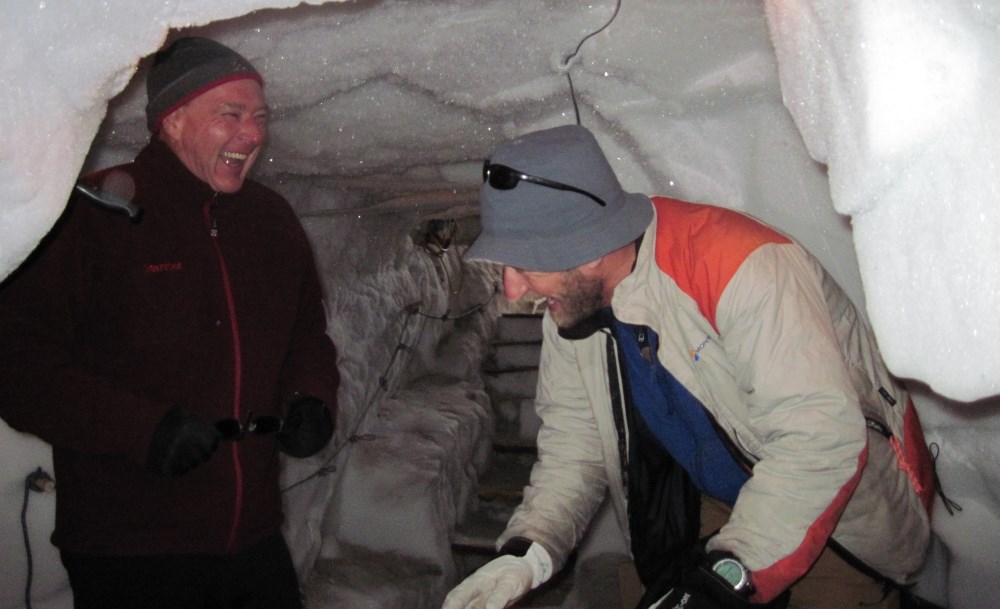
While we were in the Ice Cave, the all-the-way flyers took off for Pole in the Basler. Conditions for their flight looked just about perfect.
Saturday, January 9
I got up just in time for breakfast and the group met afterwards to discuss the day. We were told that the Otter would do a pick-up at Vinson in the morning and take us to 89°South in the early afternoon. So long as it is clear (Visual Flight Rules are absolutely mandatory) the pilots said that the ski-equipped Otter will fly. Fierce winds do not bother it at all down here because the runway is anywhere the wind happens to be blowing from. The pilots just point the nose into the wind and take off and land wherever they like.
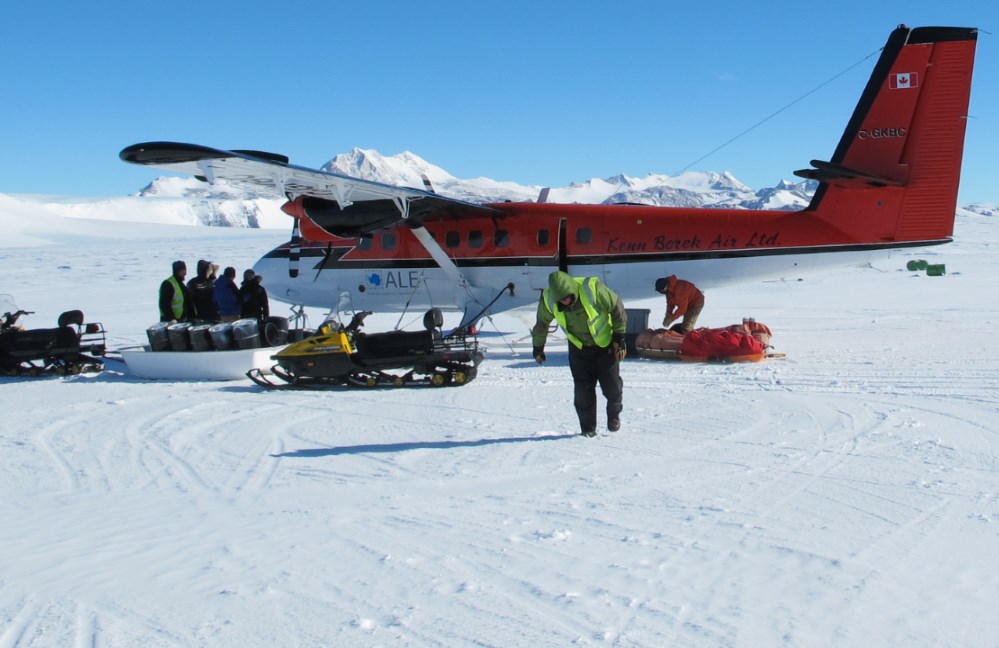
The Pole flyers got back in the middle of the night and were thoroughly delighted with the experience. Normally the guided tour of South Pole Station takes only an hour or so. On this trip, the group was able to extend the stay to four hours so everyone felt that they were treated especially well. In talking with them you get a strong sense of how satisfied they are to have made this remarkably rare journey. They will all return home with wonderful tales to tell!
…Finally, after lunch, the pilots announced that the Otter was fueled and ready to go.
Finally, after lunch, the pilots announced that the Otter was fueled and ready to go. We hauled our gear aboard and left Patriot Hills at 3pm. A little over two hours later we arrived at the fuel cache at Thiel, a beautiful spot near a cluster of nunataks. At Thiel the pilots filled the Otter’s tanks and dropped off a woman who was sent to repair the automated weather station there. She will be picked up after we are landed on the polar plateau. For safety reasons she was equipped with a tent and plenty of food and fuel for a lengthy unscheduled stay. Apparently the fuel dump is resupplied from Patriot Hills by tractor train. I’d love to go along on that seven day round trip.
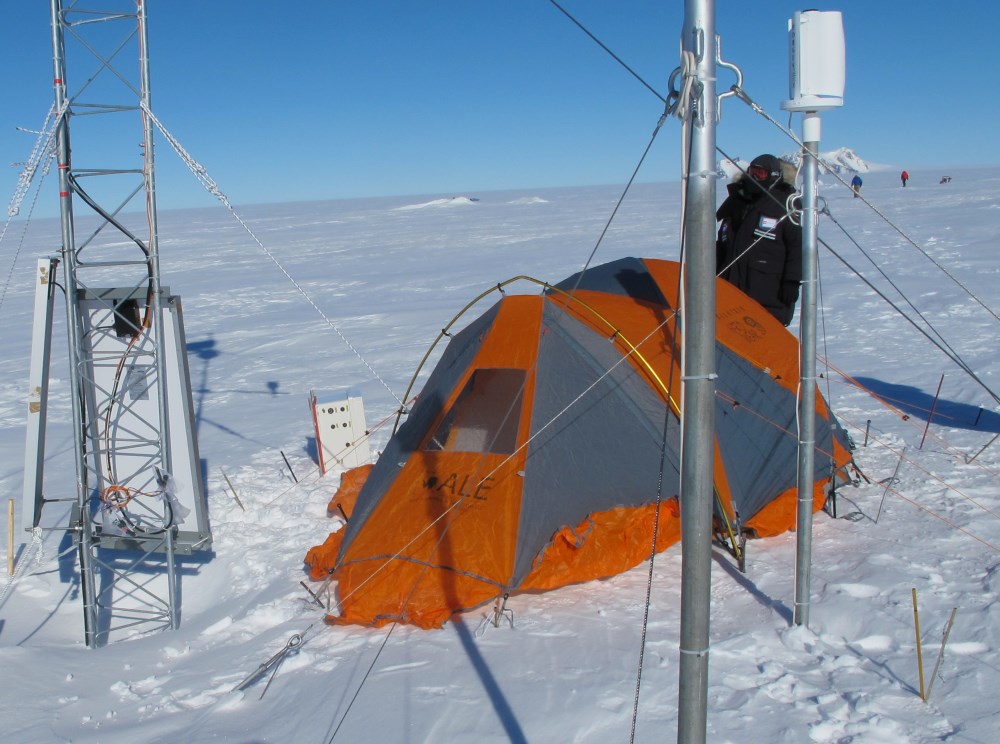
From Thiel to 89°South was another hour and forty-five minutes of flying time. The nunataks disappeared along the way and the ice went featurelessly dead flat. As we approached our destination the pilots swooped low and made several passes to assure that the drop off point was free from sastrugi. Before you knew it we bumped onto the ice and tumbled out to begin unloading. In stepping out of the plane my mental dialog of “Am I really doing this!!!?” was much the same as when I tried skydiving a few years ago. It was a curiously ambiguous experience; very exciting but not unmixed with dread.
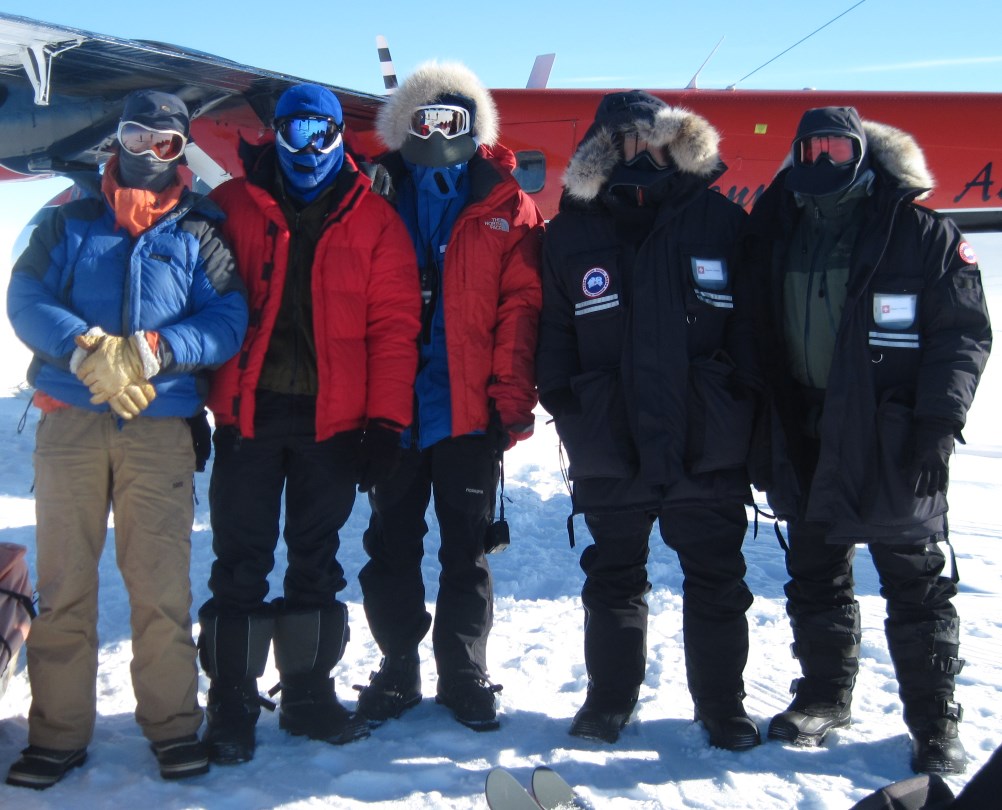
Unloading the plane was breathless work at 9,000 feet. We harnessed up our sleds and were immediately impressed by how cruelly, bitterly cold it was. After the comparatively tropical conditions of Patriot Hills, minus 28°F felt frighteningly frigid. In any event, we quickly moved a couple of hundred yards away from the still-idling plane and watched in silence as it began its takeoff roll. It popped into the air, circled back and buzzed us low overhead wagging its wings. It soon disappeared from view and we were alone, literally in the middle of nowhere. By GPS our position was 94°West about one mile north of 89°South. So, our adventure was to be seventy statute miles rather than sixty-nine.
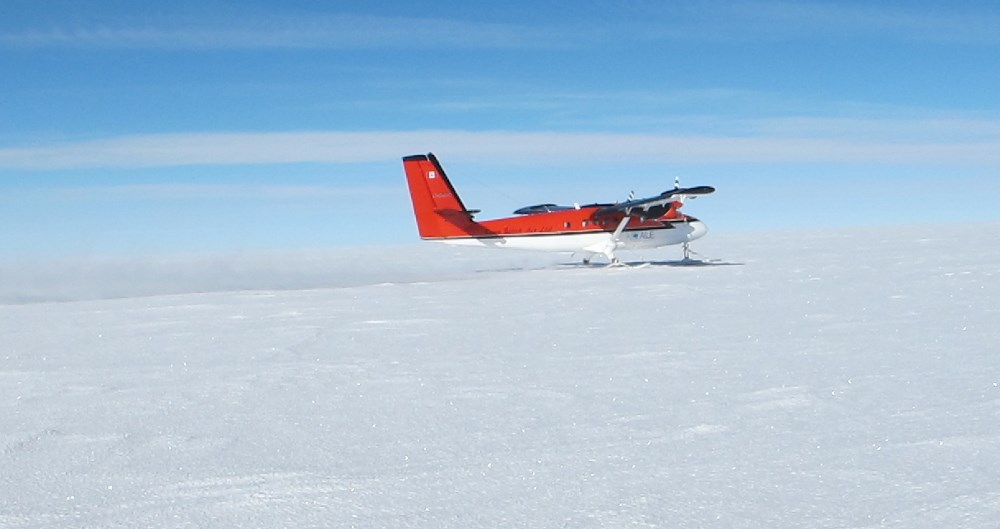
We trudged off with our sleds in full combat gear. Even with my big down parka on I was shivering and my hands were very cold. Fortunately, after just a few minutes of travelling I warmed right up. We went at a very slow pace with the objective of just covering the distance to our official starting point at 89°South.
The snow was crystalline and light. Even on skis we sunk in an inch or two. However, the sleds pulled well and it was no problem to make progress. I felt that all was under control and my apprehension faded. In no time (a bit under an hour) we were at our stopping point and within forty-five minutes after that were settled in our tents.
We had a big dinner and afterwards I tested the “WAG bag” for the first time (very intuitive!). It is good that the rules of engagement are strict and that removal of all waste is mandatory. What a shame it would be if this pristine wilderness were allowed to become a dumping ground!
The plan for tomorrow is to sleep in as late as we like and have a light four hour day. This will be great to help us all acclimatize.
Sunday, January 10
We slept until 9am and did not hurry at all to get underway. In total we trekked for three hours and fifty minutes and called it a day early in the afternoon. We covered about five nautical miles which was not bad since we stopped twice per hour for rest breaks.
…Consistent with polar tradition we are keeping track of our progress in nautical miles.
Consistent with polar tradition we are keeping track of our progress in nautical miles. The early explorers were all seamen who lived and breathed in a world described in nautical miles. What worked for them would do just fine for us. A nautical mile equals 1.15 statute miles and 1.85 kilometers.
When we started out it was cold (minus 20°F) and mostly cloudy. It brightened a little, darkened again and then became reasonably sunny. The wind was moderately stiff in the morning but lightened later. However, the soft surface has its hazards. Without the flotation provided by skis you sink in six inches with each step. When clumping about in the morning sans skis I twisted my ankle alarmingly. It recovered quickly but the incident reminded me of the need to be cautious. It would not be fun to ski to Pole on a sprained ankle.
For most of the day I traveled abreast of Lars and Rob. It was amazing to consider that we were likely the first humans ever to set foot on that ground. In choosing our drop-off point Rob selected a longitude that was far off the beaten track to assure that we’d not have the tracks of earlier expeditions to follow.
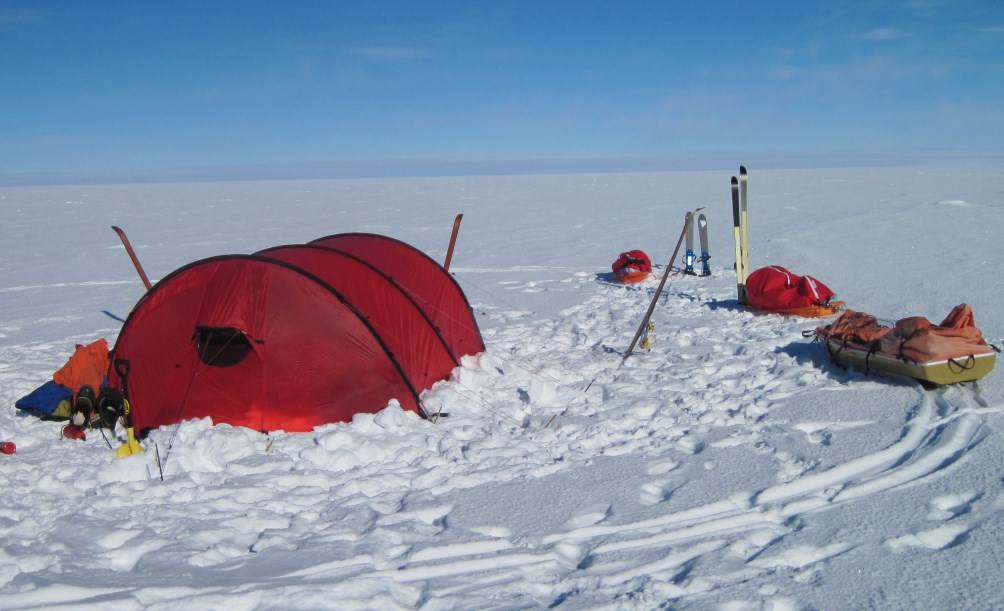
My only physical concern during the trek was that my left big toe went completely numb. It neither hurt nor felt cold but was disturbingly insensate. Now, a couple of hours after entering the tent (6pm), it feels largely all right. I think that my boot is just a little too tight in the toe. I’ll address this by wearing one fewer pair of socks tomorrow.
The plan for tomorrow is to stay on the trail for a full eight hours. I’m looking forward to a higher mileage day tomorrow so that we can really start making inroads against our goal. The constant tug of the sled behind is mildly annoying but, on the other hand, my sled is unexpectedly light (only fifty pounds or so), snow conditions have been great and there is nary a hill in sight. I am so glad that I chose this trip over Vinson!
It is now a little after 6pm, we have had a good dinner and I’m going to read for a while. It is wonderfully comfortable in my ultra-warm sleeping bag.
Monday, January 11
We got up at 8am and started trekking two hours later. Our morning routine has Rob firing-up the primus stove immediately upon waking and me scrounging through the food bags to find coffee, tea, cereal and other breakfast items. The packets of instant oatmeal we are carrying make for a delicious breakfast. It is nice to have something tasty to look forward to in the morning. Also, for the first time ever on a camping trip I’m having instant coffee. To my surprise it is quite good, infinitely better than tea or the plain hot water that I usually take. The smell of the stuff, particularly before adding water, is wonderfully (surpise!) coffee-like.
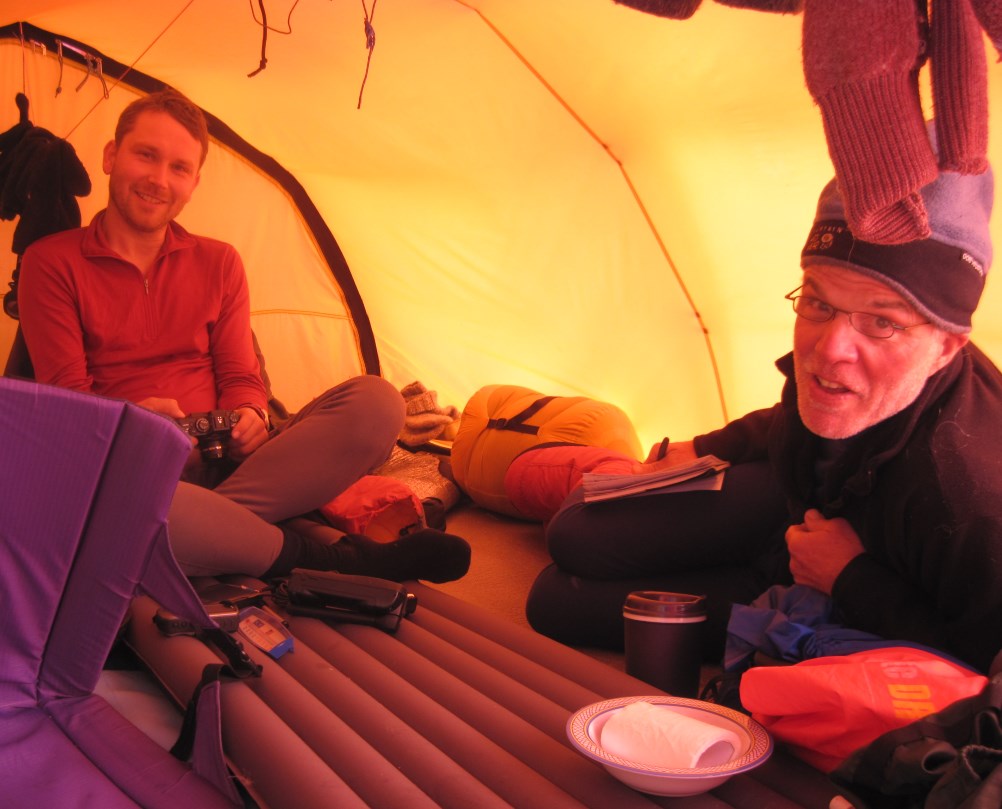
Melting water for breakfast and brews is time consuming. We have to make enough hot water to fill a thermos and a Nalgene for each of us. We all stay halfway in our sleeping bags while the brews are made and breakfast consumed. The stove warms the tent up very effectively so waiting for the hot stuff to be produced is no hardship. Once we have tanked up for the day it is just a matter of putting on pants, boots and outer layers and then venturing outside to face the day. Breaking down camp and re-loading the sleds takes only about twenty minutes. It is easy to take the tent down because it has an integrated fly and rolls up without the need to fully remove the poles. This is infinitely easier than with the expedition tents that are typically used for mountaineering. Because both tents fit easily in Rob’s big pulk there is no need to be fastidious about folding them. They do not need to fit in anyone’s backpack!
It was overcast and dull in the morning. Our goal was to do eight hours and cover ten nautical miles. With a couple of acclimatization nights under our belts we decided to dispense with twice-hourly breaks and get into a fifty minutes on / ten minutes off schedule. As an incentive to us all Lars has attached a “ONLY 55 NM TO GO!” sign to the back of his tow harness. This is a great idea and it will be fun to see the numbers decline from day to day. Lars is definitely a fine tent-mate.
While on the move the time went slowly but pleasantly. I carefully (obsessively?) monitored my physical condition and to my great satisfaction found that I was feeling just fine. My toe was still a bit numb but apart from that I was quite happy with sledging life. At the hourly breaks I have been careful to always have something to eat and drink. The ALE-provided snack food amounts to about ten pounds per man. It is all good stuff but every morning I look at the bag in my sledge and rue having to haul all of that stuff. I am quite certain that I’ll never touch more than a fraction of it.
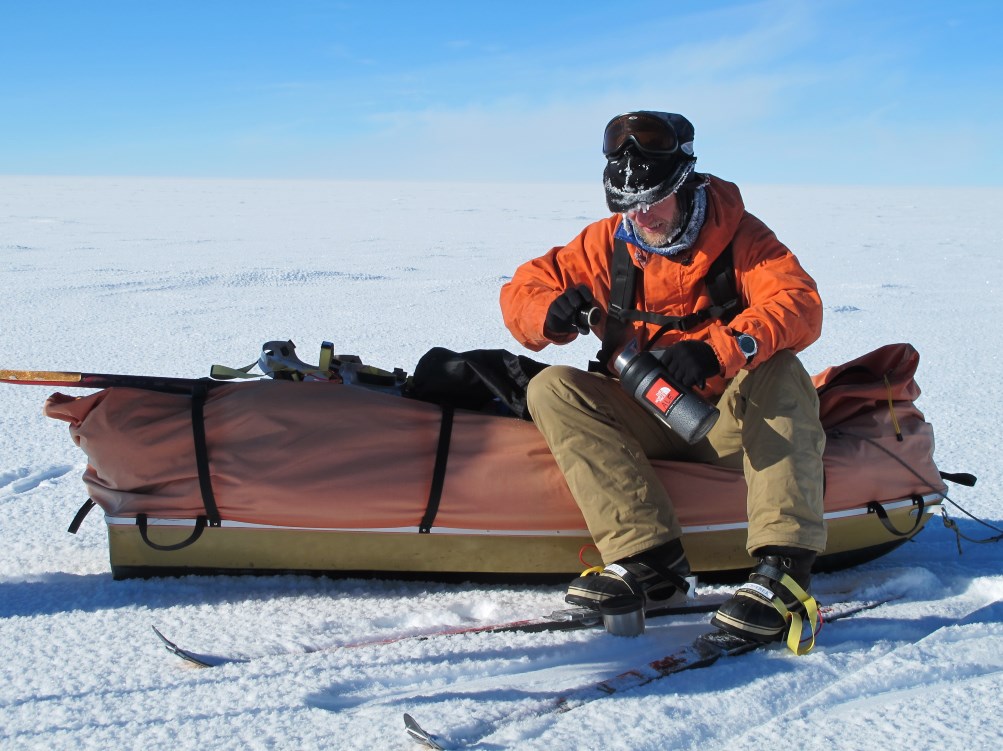
To pass the time I spent a good part of the trek reliving my eight-mile hiking route from home. It was fun to relate our snail-like progress against that familiar old standard. By the end of the day I had mentally completed the route. In real life we covered about eight and a half nautical miles and took seven hours to do it. This, of course, was below expectations and slightly disappointing. However, after making good progress for the first three hours, the altitude caught up with Patrick and he had to go slowly. He started the day with a headache and struggled with it all day long. It was a good call on Rob’s part to cut an hour off the day and camp early. I was very impressed with Patrick’s grit. It was clear that he felt miserable but he soldiered on in spite of it. It would have been very easy for him to ask for a rest day instead of continuing. He’s a good man.
Tonight dinner was particularly good. Rob broke out a big square of brownies and once they had thawed a little they made a wonderful treat. This, along with ramen noodles for a starter and pesto salmon freeze dry for the main course made us full and content.
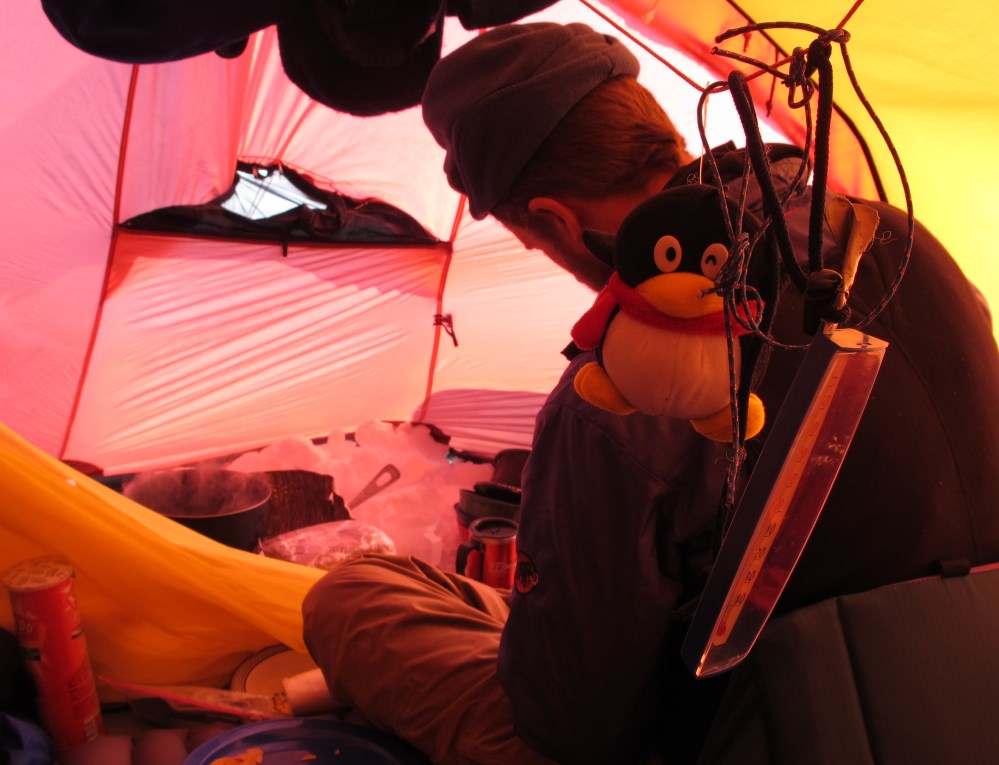
Tuesday, January 12
We got a 9 am start (meaning we awoke at 7 am) and left camp in remarkably warm (about minus 4°F) and wind-free conditions.
I had a splendid time through the first five hours. To pass the time I reviewed my morning routine and reveled in the memory of so many pleasant details of ordinary life. Otherwise humdrum daily events took on new life and warmed me to the core with the knowledge that I’d resume all of it in just a couple of weeks’ time. Who’d have known that the memory of driving to a local breakfast place, sipping my morning coffee and reading the paper while eating could have produced a reverie lasting for hours?
… five and a half hours into the trek the evil gremlin of equipment problems struck. My right front ski binding broke in an awkward and non-repairable way.
Then, five and a half hours into the trek the evil gremlin of equipment problems struck. My right front ski binding broke in an awkward and non-repairable way. The plastic strap snapped at its base. The good news was that we had a spare pair of skis. The bad news was that they were the same long cross-country skis that I had tried unsuccessfully to use back at Patriot Hills. There was nothing for it but to try. Unfortunately, after a trial of half an hour it was painfully obvious that I’d never get to Pole on that pair of skis. The right ski was okay but the left one rolled uncontrollably outward with every step. My boots and the bindings simply did not mate up correctly. As a stopgap (and maybe the awkward permanent solution), I ditched the left Asnes ski and substituted the good Karhu one. This combination was freakish and disconcerting to use but not impossible.
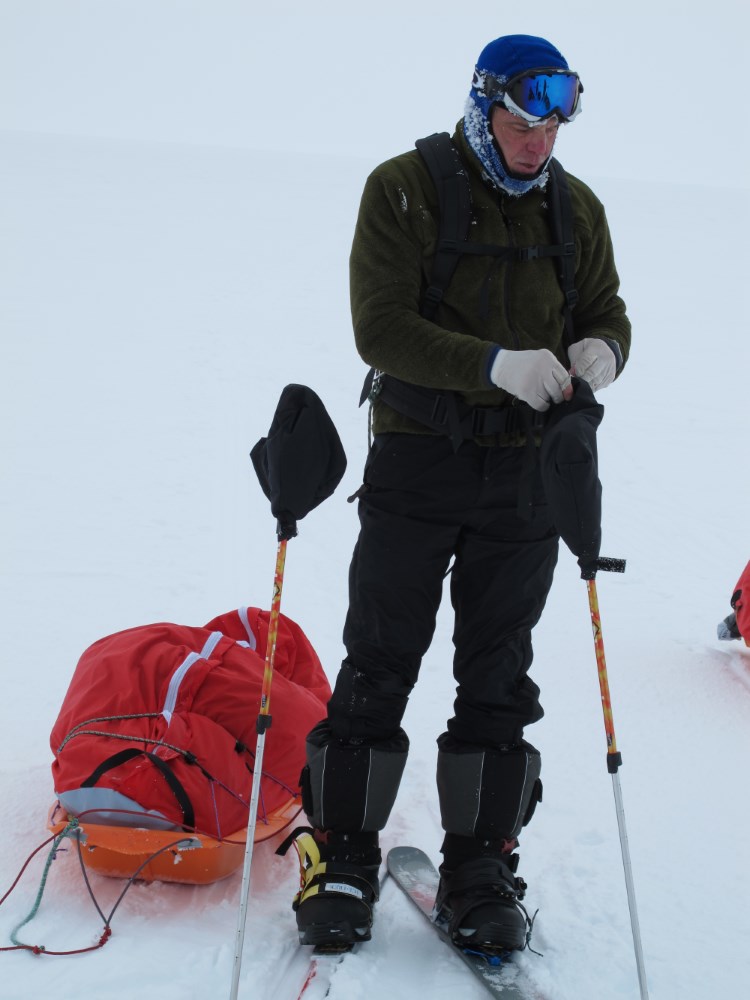
I plowed ahead with the mismatched skis for the remaining two hours of the day.
We quit at 5 pm after eight hours and nine nautical miles on the road. Our mileage was a bit lower than planned but the altitude was still bedeviling Patrick and it made sense to go at a deliberate pace. It felt odd to be covering only a bit more than one nautical mile per hour but it was definitely relaxing. By day’s end Patrick expressed that he was feeling much improved and hopefully he’ll be fine tomorrow; ditto for me and coming to terms with my equipment problems. I looked at the broken binding after dinner and think that I’ll be able to use a compression strap as stand-in for it. This was very encouraging but the proof will be in the pudding tomorrow.
The plan for tomorrow is to do nine hours and cover at least ten nautical miles.
Wednesday, January 13
We did a big nine-hour day today, starting at 9 am and carrying on until 6 pm. We covered a best-ever eleven and a half nautical miles.
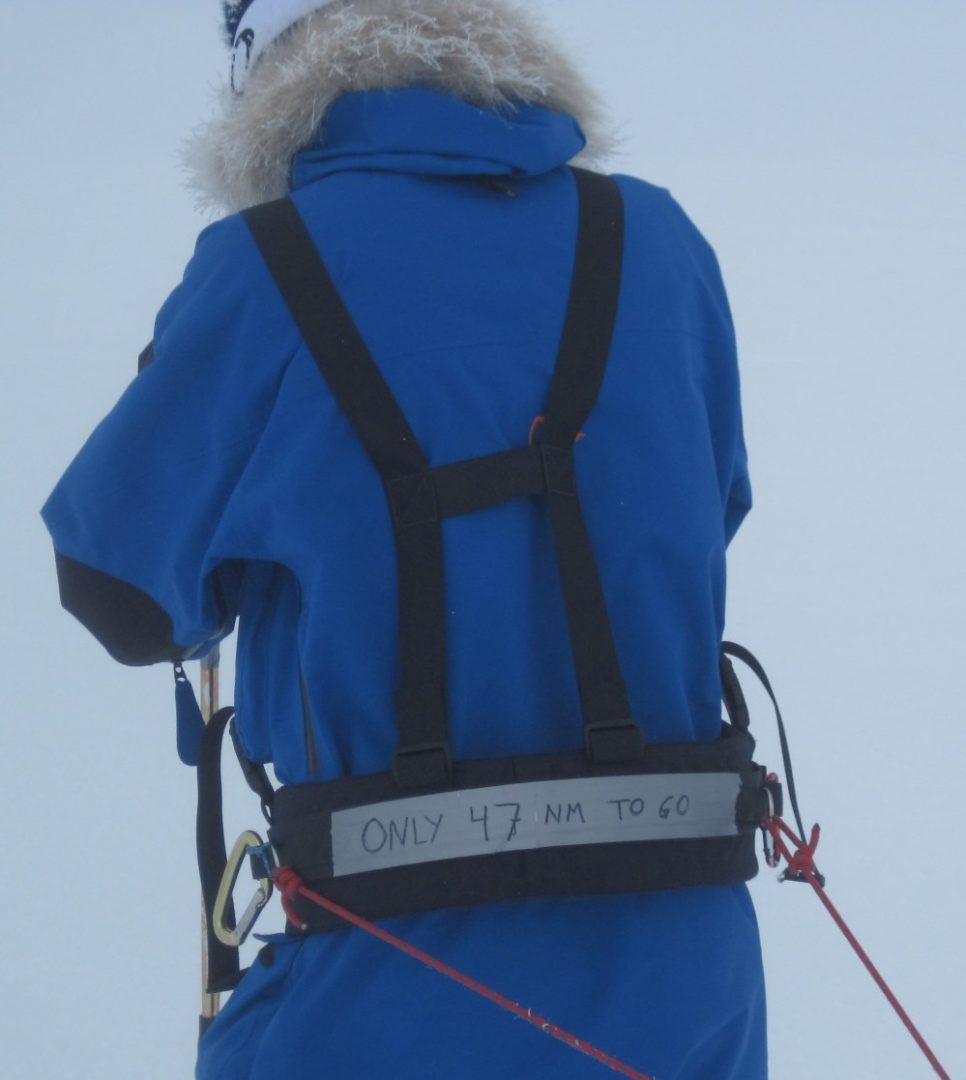
Before we started I fixed my right Karhu ski with a compression strap. Within minutes I felt fully confident that the fix was good and that I’d be able to complete the trek with a matched pair of skis. This was an incredible relief! After the second hour I modified the fix by removing the broken plastic remnant from the old binding and threading the compression strap through the slot. This made the fix absolutely perfect.
After three hours of murky conditions it cleared rapidly and we enjoyed brilliant sunshine for the remainder of the day. The warming effect of the sun was such that for one leg I wore only a Capilene base layer and a polar fleece pullover on top. For most of the trip so far I’ve supplemented those layers with a fleece jacket, occasionally topped with a down vest. Astonishingly, I’ve never worn my Gore-Tex hard-shell jacket and have had my down parka on only briefly. On the legs I’m wearing Gore-Tex pants over light wool tights topped with a mid-weight Capilene layer. I could easily do without the third layer on the legs. I put the Capilenes on a couple of nights ago because it was quite cold in the tent but, since then, the cold has not been a problem. I’ve just been too lazy to remove them. My hands have been just fine with silk liner gloves under polar fleece outer gloves. As Hannah attested, the pogies attached to the ski poles are very effective. Half the time I do not even use the polar fleece gloves and I have not been at all tempted to put on my big down mittens. I only wish I had a spare pair of the silk gloves. I’m afraid my fondness for them will be their ruination; after a week’s hard use they are full of holes. Ski goggles and a balaclava complete the outfit. High quality goggles are a must and so far mine have resisted icing. For most of the afternoon the temperature was somewhere around minus 4°F. This was absolutely balmy compared to what I expected and the wind has not been overly troublesome either. With conditions this good, today’s long day was hugely opportunistic.
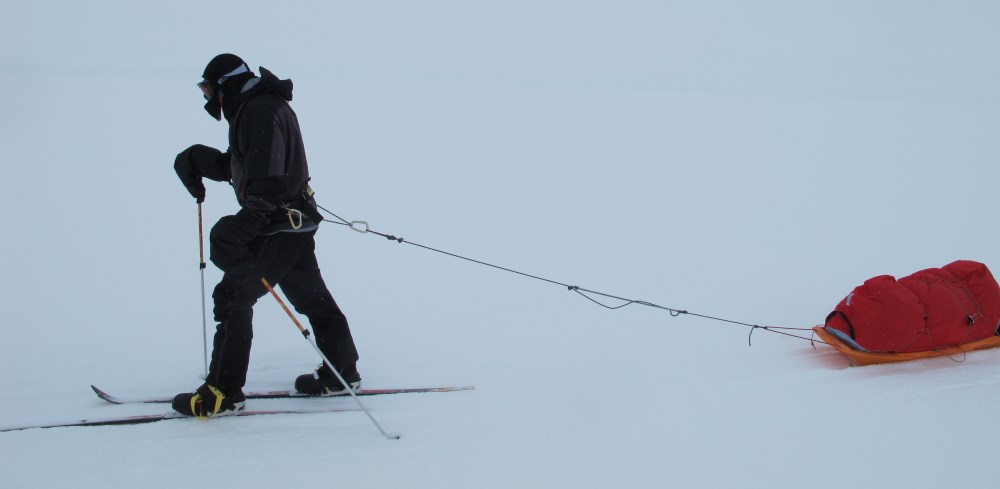
We passed 89°30’ South in mid-afternoon, our halfway point, so it is downhill all the way from here! Fortunately, everyone is now feeling well and going like trains.
While nestled cozily in our tents after dinner we discussed plans for arrival at Pole. By doing two eight-hour days, we’ll be within hailing distance assuming we can cover ten nautical miles per day. While the sign on Lars’s harness now says “ONLY 26 NM TO GO!” we figured the actual distance is a few miles longer because we have to do a two and a half mile dogleg around an abandoned antenna that parallels the South Pole runway. Our thought is to arrive late Saturday and tour South Pole Station at leisure on Sunday. The alternative is to do nine-hour days so as to arrive and take the Station tour on Saturday. I like the idea of eight-hour days because nine hours is decidedly long and I want to allow enough time to get a good visit to the Station and its environs. Happily, this is the plan we agreed.
Despite my satisfaction with the repair of my skis, I’m still not completely happy with the way the skis and boots work together. My boots are plenty warm but ridiculously clumsy. They lack any semblance of ankle support and make me vulnerable to rolling and spraining. Oddly, the problem is much worse on the left side. Try as I might to tighten them up, it is of little use and I have to ski cautiously, particularly in loose snow. This is one area where my pre-trip preparations fell woefully short. After fifty miles of practice hikes in the Baffins at home I knew that they we not much to my liking. I should have tried other alternatives before coming to Antarctica.
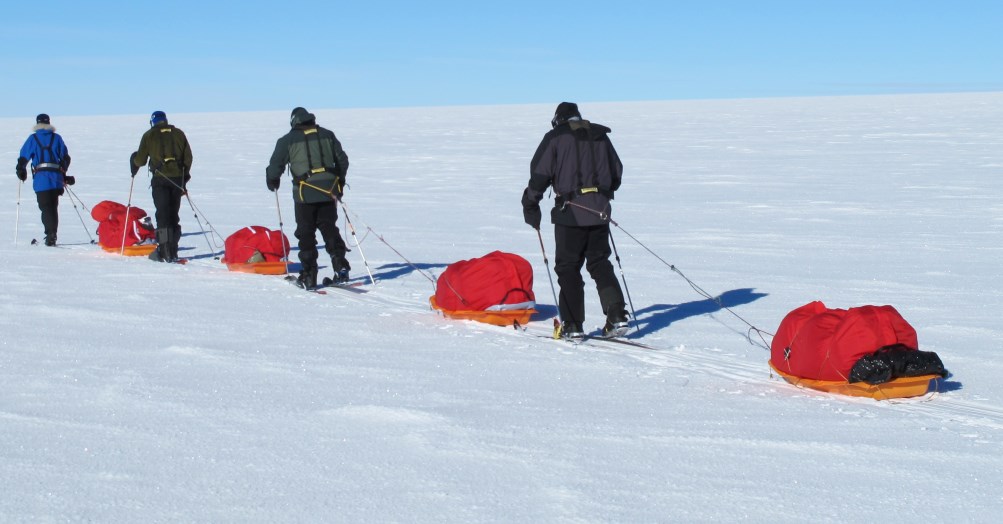
It is now 9:30 pm and time to read and rest. Oh yes, I almost forgot to mention that today we all took an hour in the lead. This was nothing new for Lars but a first for Patrick, Stephan and me. Navigation was a breeze for me because my stint started at 3 pm, the hour when the sun is in its most northerly position and directly behind us. All I had to do was walk on my shadow to be certain I was headed due south. Sunny days make navigation easy. In the morning when we start the sun is in the east so going south is just a matter of keeping your shadow on the right. With every hour between 9 am and 3 pm you just need to let the shadow rotate a bit counterclockwise until you are eventually walking right over it. After 3 pm you let it swing to your left side and by 9 pm it is fully to your left.
Thursday, January 14
Today we did another eight hour day, this time with nine point six nautical miles covered.
I found the day tedious and stressful. For the first four hours the snow conditions were loose and unconsolidated. My left foot began to roll outward and I was preoccupied with the thought that the strain would cause an injury. Happily, conditions eventually improved and the pressure on my ankle let up. In the final two hours of the trek we were blessed with perfect, hard snow conditions and my foot issues disappeared altogether.
…this trip has been considerably easier than expected. I think a Last Degree trip is a reasonable goal for lots of people.
Apart from fretting about equipment, this trip has been considerably easier than I expected. Before coming here I’d read that people compare Last Degree trips with mountaineering expeditions to 8,000 meter mountains. Thank heaven, I do not think they are even remotely comparable. While skiing for eight hours a day demands a good level of fitness, the terrain in pancake-flat. Even if the “skiing” is more like trudging because there is no glide whatsoever, at least you are trudging on the flat. Eight-thousanders are anything but flat and make your life miserable because of it! I think a Last Degree trip is a reasonable goal for lots of people.
The day started out foggy and grey. After a few hours the fog lifted but we had no hint of sun all day. The light was perfectly shadowless and flat. This made navigation a by-GPS exercise entirely. Lars led the way most of the day with he and Rob trading front for back every couple of hours. To keep the GPS in view they used a harness (the “strap-on”) which cleverly allowed the GPS to be bungee-corded to a plastic mount a foot or so out from the chest. On days where the visibility is bad and no shadows exist to give directional clues, the GPS is absolutely invaluable. Without it you would soon be traveling in circles and would never reach Pole.
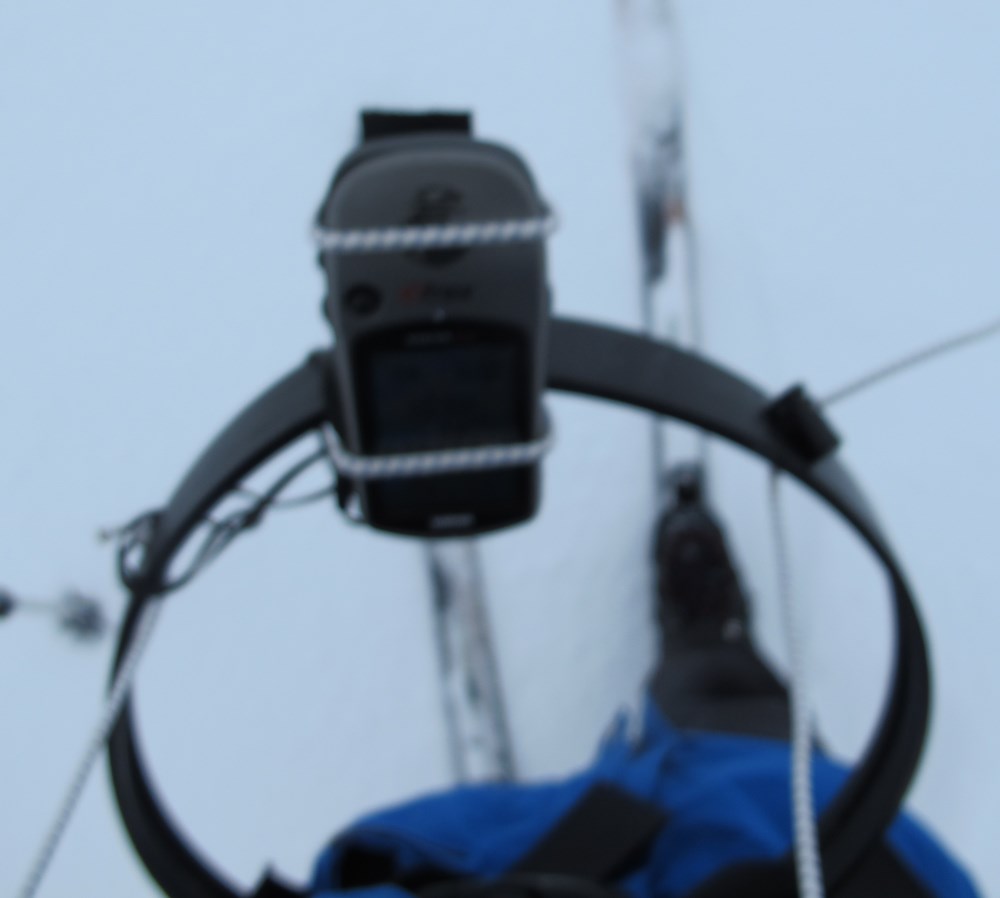
I spent the first six hours of the day trying to visualize yet another of my standard routes from home but could not conjure up much enthusiasm for it. Once underway, it is hard not to be a little bit bored. There is absolutely nothing to see in any direction. It is remarkable how quickly the novelty of being on the polar plateau fades! Even Stephan, normally the most stoic of travelers, groused about the unrelieved emptiness of the terrain. He said he prefers the views in Switzerland.
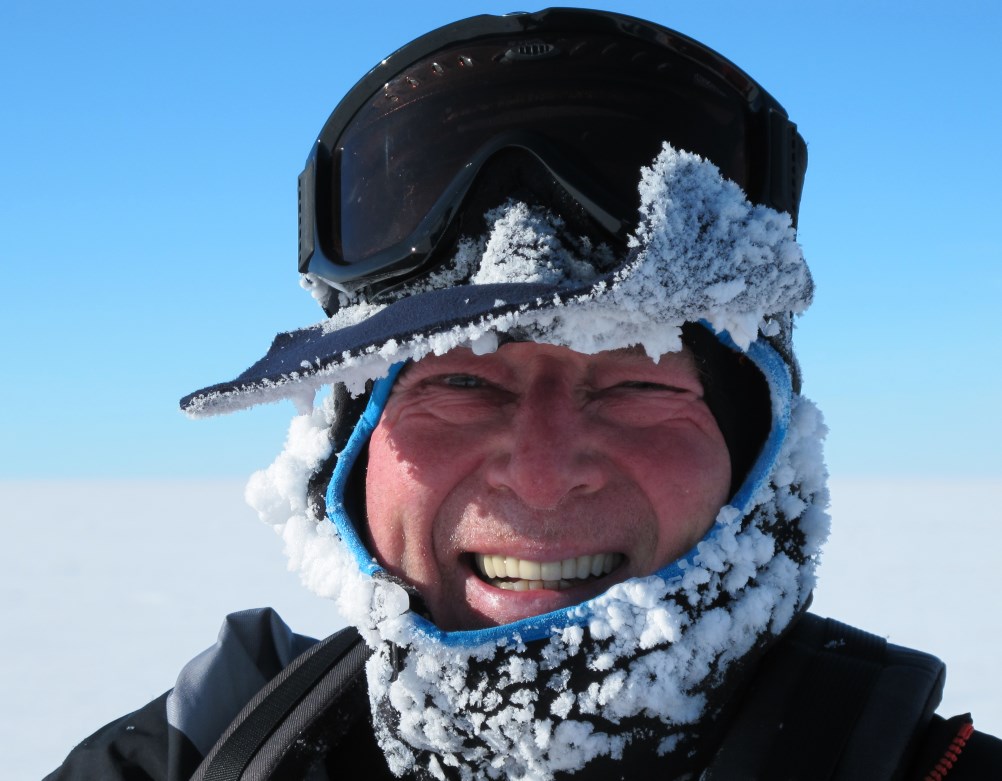
In mid-morning we had the startling experience of sighting another skier. It was undoubtedly Meagan McGrath, a soloist who left Patriot Hills thirty-nine days ago. We extended a break in order to allow her to catch up to us but she evidently did not want company. I guess that she might have felt that meeting another party would compromise her “solo” claim. In any event, she avoided us and, traveling at a clip of fifteen nautical miles per day, soon outstripped us and was lost in the mist. We pondered long and hard about the route she was taking. When we first sighted her she was about half a mile east of us. During the next couple of hours she crossed over our track and disappeared well to our west. Since we were sure that our heading was due south, Meagan’s south-west trajectory was puzzling. Lars’s theory is that she was using the map feature of her GPS to navigate rather than the pointer-arrow. It is his experience that the map is misleading because it attempts to flatten a spherical world. Who knows? In any event, we all sympathized with Meagan’s decision to keep her distance from us. After thirty-nine lonely days and the end close at hand a chance meeting might have been emotionally uncomfortable for her.
While in Patriot Hills we heard about the nearly deadly start Meagan’s trip had. She was dropped off at the traditional all-the-way starting point at Hercules Inlet some thirty miles distant from Patriot Hills. During her second day on the trail she plunged into a hidden crevasse and, though uninjured, was unable to get out. Miraculously, she was able to get a signal on her Iridium phone and call for help from the depths of the crevasse. Within hours, a team from ALE found her and plucked her out. She was brought back to Patriot Hills and, after a few days of reflection, made the decision to continue her journey from there. Amazing stuff!
We had a four-star dinner tonight in the tent. Rob is by far the best camper-cook I have ever traveled with. We snacked on a slab of carrot cake and, in addition to the usual soup and freeze-dry, had an appetizer of freshly cooked beef strips. Our provisions include packages of uncooked chicken pieces and beef strips. Why the stuff was not pre-cooked back at camp I’ll never know but Rob is clearly up to the task of preparing gourmet food over the primus. He fried and seasoned the beef to perfection and we all enjoyed it immensely. As usual, Patrick and Stephan saw to themselves in their own tent, a situation which they apparently are completely happy with. All I can say is that they don’t know what they’re missing.

After dinner, the in-tent routine is always pretty much the same. We chat and plan for the following day and at 8 pm Rob calls Patriot Hills on the Iridium satellite phone to report our position and status. Meanwhile, Lars unlimbers his own sat-phone and handheld computer to update his South Pole trip blog. Lars’s blog is very popular back home in Houston. Via it I’ve gotten a number of e-mail greetings and questions. Most every night Lars announces that “Mr. Popular” has a new message. It is terrific that the folks at home can follow along via the blog and get daily updates of our doings. Meanwhile, in the other tent Stephan and Patrick also have an Iridium phone and they touch base with home nightly. We have a total of four sat-phones among us (Rob has a second as a spare) so we could easily do conference calls from the Antarctic Plateau. Technology is wonderful!
Our campsite tonight is seventeen nautical miles from Pole. By the end of tomorrow’s march we should actually see South Pole Station. To all of us, Pole is becoming more “real” with every passing day.
It is now 12:45 am and I have been awake for an hour. After snuggling into my sleeping bag at 9:30 pm, Job #1 was to get warm. The tent was freezing. Now, it is exactly the opposite. I have taken off my Capliene top and am sitting up bare-chested and sweltering. The sun is shining brightly and has turned the tent into a greenhouse. This is amazing because I went outside a few hours ago with three layers on and mentally concluded that it would be certain death to remain outside, so dressed, for any length of time. Antarctica is a strange place with extremes at every turn.
Friday, January 15
We did our usual eight-hour day today and logged better than ten nautical miles, a very encouraging performance. The snow was firm and my left ankle enjoyed a day of ease. It was cheerfully sunny with just a bit of haze. However, putting an exclamation mark on how cold it gets down here, I’ve now got a bit of frostnip on my face. My balaclava evidently slipped below my goggles at some point and before I fixed the problem the cold left its mark. You have to be ultra-cautious about not exposing any skin while underway because frostnip (or worse) is never more than a few minutes away.
…the big payoff came about nine nautical miles out from Pole when we spotted a dot on the horizon.
The big payoff came about nine nautical miles out from Pole when we spotted a dot on the horizon. The dot was a slightly brighter white than the sea of ice at our feet and the white-on-white horizon. At first you could not be sure you saw anything at all but in time the image sharpened and you could look away and quickly find it again. Pole was in sight! I guessed that the dot might be the metal-clad “beer can” tower at the end of the Station. Others guessed it might me the ten-meter telescope structure. (It actually turned out to be a radar dome.) In any event, it was undeniably something put there by the hand of man. After looking at nothing but icy vastness for days on end, it was a sight that delighted the eyes.
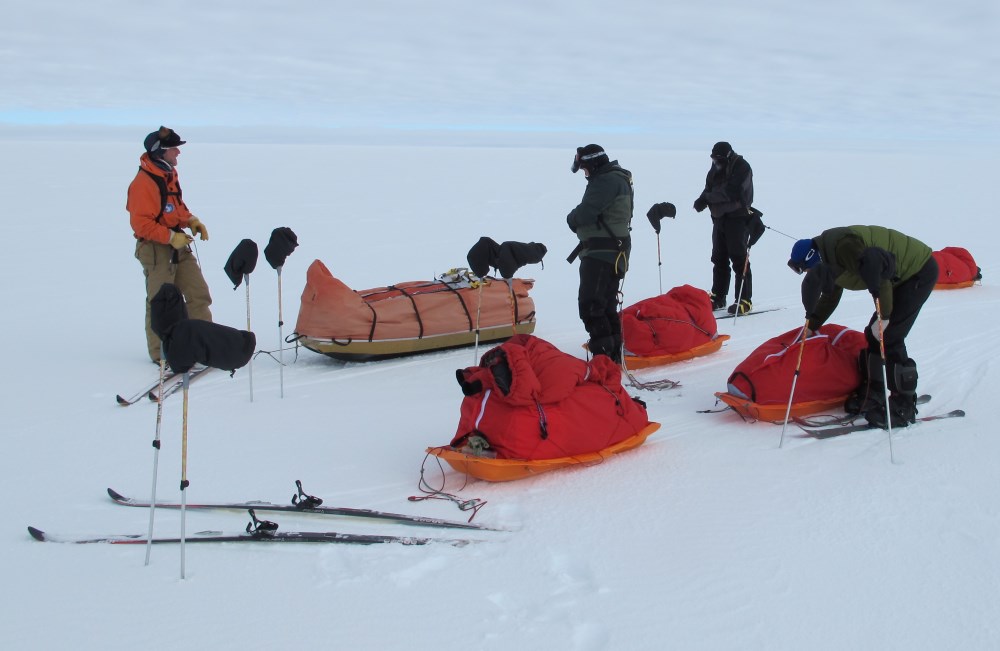
The plan for tomorrow is to get up and out an hour early and do the remaining seven or so nautical miles at as good a pace as we can manage. We will set up camp at Pole, sightsee and be ready for a tour of the Station at 7 pm. The tour time is subject to change. The Station operates on New Zealand time (plus sixteen hours from the Chilean time we use), so 7 pm, Saturday for us equates to 11 am, Sunday for Station personnel.
I am hugely excited to have Pole in view. I went outside the tent at 7 pm and the haze has lifted so you can plainly see low smudges of buildings in the distance. Tomorrow our efforts will be fully rewarded.
Per this evening’s conversation with Patriot Hills, we will overnight at Pole on Saturday and be picked up by the Basler on Sunday. Evidently the Basler is being deployed because it has a load of fuel to depot at Pole. Whatever the reason, I am thrilled at the prospect of using the Basler. I have not flown in a DC-3 since the early 1970s. This is a stroke of good luck for us!
Saturday, January 16
We reached Pole at 1 pm today following a 6 am wake-up and 8 am start, having covered the remaining distance in five hours.
The day started inauspiciously when the plastic buckle on one of my boots broke. However, with Pole in sight and the boots providing virtually no support in any case this was more of an annoyance than cause for concern. I swear I’m going to toss these boots in the garbage when I get home!
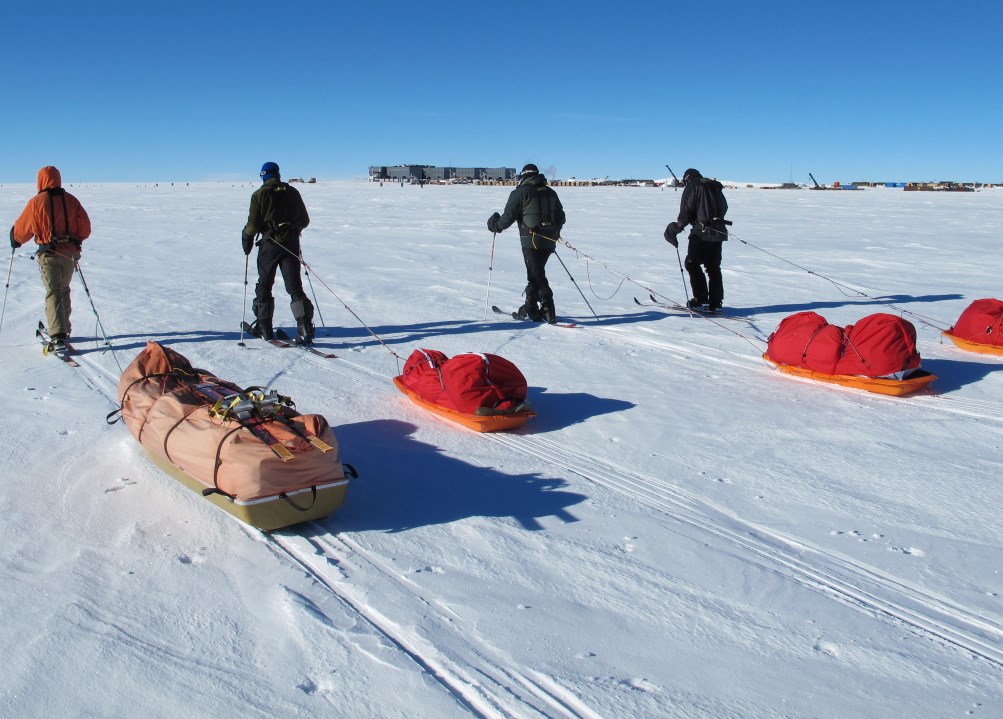
The trek to Pole seemed interminable. Seeing the buildings heightened our anticipation and it took forever for them to rise out of the ice. Our route was not direct. We had to divert around a long high frequency radio antenna and this left us two and a half nautical miles behind the main building on the Destination Alpha side. “Destination Alpha” is the Station’s main entrance. Once at the end of the antenna string, we turned left and marched in parallel to the ice runway. It was profoundly cheering to see green flags along the runway guiding us to the prescribed crossing point and the Station growing minutely bigger with every step. As we got closer it became clear that Pole is a gigantic construction site. There were hundreds of containers in irregular rows holding god-knows-what in construction supplies and debris. My guess is that a lot of them contain the remnants of the Dome, the iconic circa-1975 building that the new elevated Station replaced. Disappointingly, the old Dome structure has completely vanished from view. I had hoped that we’d get to see a piece of it before its removal was completed. Alas, the construction crews have been too efficient. (We later learned that the last panels came down just one day before we arrived.)
…the last panels of the old dome came down just one day before we arrived!
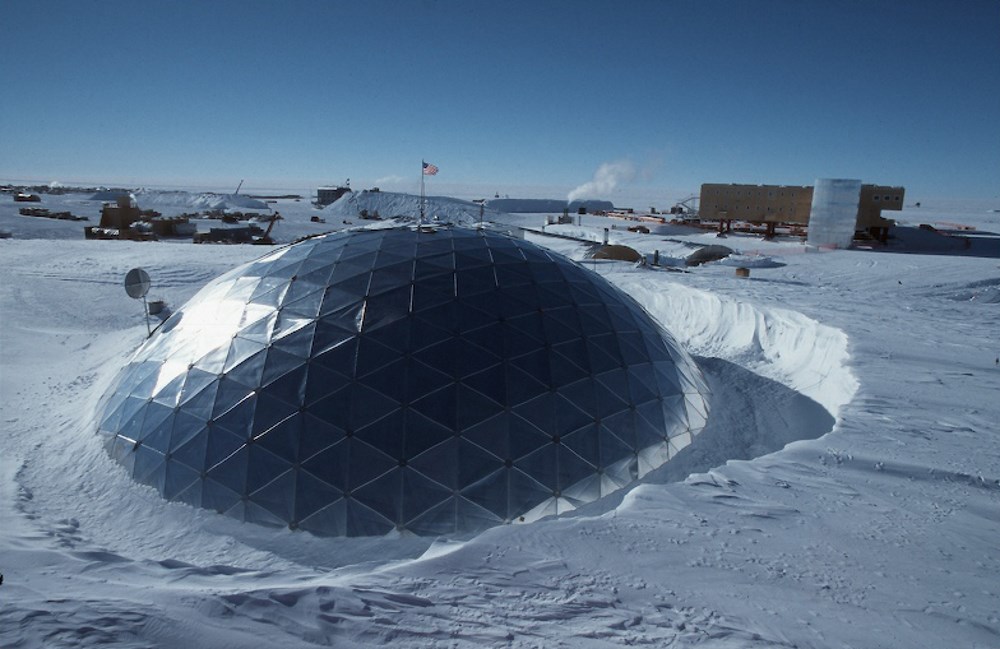
The incongruity of the Station, standing innocently on pylons that elevate it well off the ice, increases as you approach. It is solidly gigantic in a place where nature intended nothing to be. It radiates a sense of bulletproof security and the triumph of technology over place. The Station is more prosaic than pretty; its grey aluminum-clad exterior would be at home in a suburban office park. With it looming ahead we were suddenly out of the wild and back in the world of men and machines, fresh-brewed coffee, lunch at noon, high-definition television and comfortable beds at night. Where Scott and Amundsen saw emptiness we saw all this. You could not help daydreaming about what the members of Scott’s doomed party would have thought had the Station greeted their beleaguered eyes.
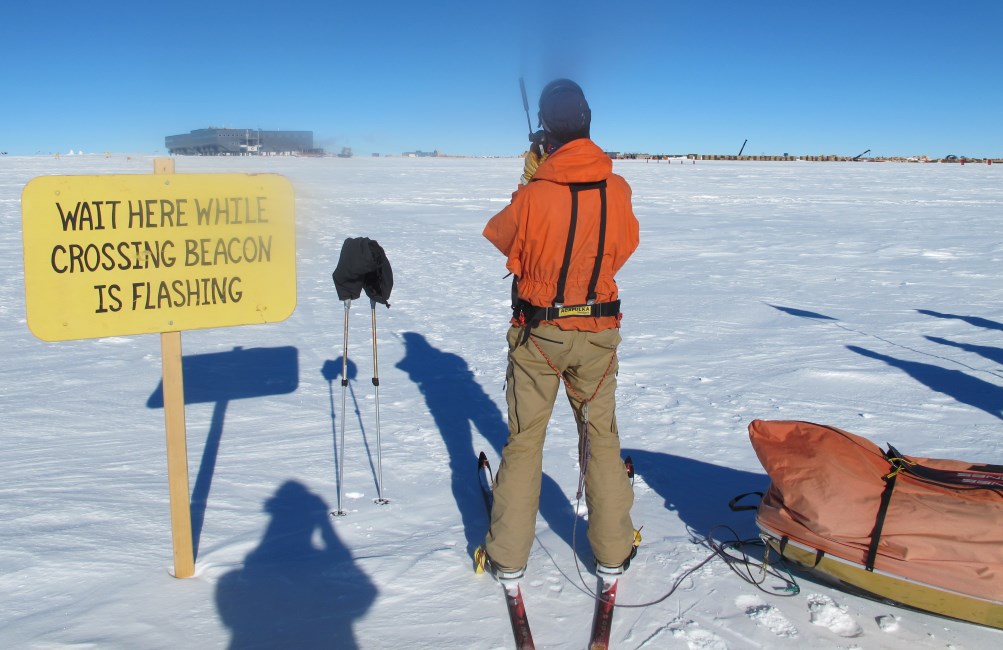
We slowly drew abreast of the Station and arrived at the runway crossing point. Rob called the Communications Office and we were given permission to cross. With the ceremonial Pole and its semi-circle of flags just yards away a guy emerged from the Station to meet us and give us the rules governing our stay.
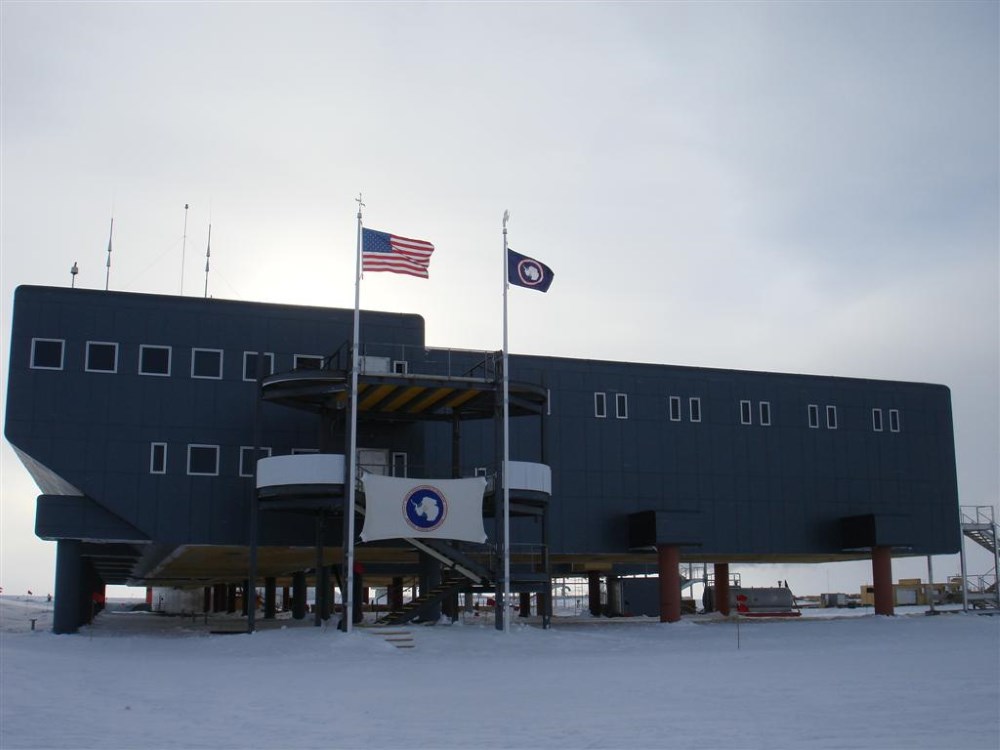
Basically, we are quarantined to a small camping area and were told not approach the main building, science buildings or anything else at the site. The kid who came down was friendly but his here’s-the-rules briefing was a bit over the top. We politely listened but all we really wanted was to get on to the Pole just a few feet away. He was dressed in frivolously light attire (no jacket, just a hoodie sweatshirt) calculated to send the message that as a bona fide Polie he is immune to the cold. He said that he is employed at Pole as part of the kitchen staff. Apparently it is plenty warm inside the Station or maybe he could cuddle up to a hot oven once he got back inside. In any event, based on his elfin size and officious manner Lars christened him the “Oompa-Loompa”.
The Oompa-Loompa eventually went away and we were then free to unhitch our sleds and walk the remaining distance to the Pole. We went to the true Pole first and then to the ceremonial one. Our arrival was one day short of the ninety-eighth anniversary of Captain Scott’s. Happily, none of our crew was snow-blind, ravaged by scurvy or struggling with frostbitten feet.
After seeing dozens of pictures of the ceremonial Pole, I was astonished at how small the actual thing is. The flagpoles are only eight feet high and the silver globe and its barber-shop striped stand are curiously unimpressive in person. Nonetheless, it felt mighty good to be there. It was anti-climatic in a good sort of way to actually touch those icons, both real and ceremonial.
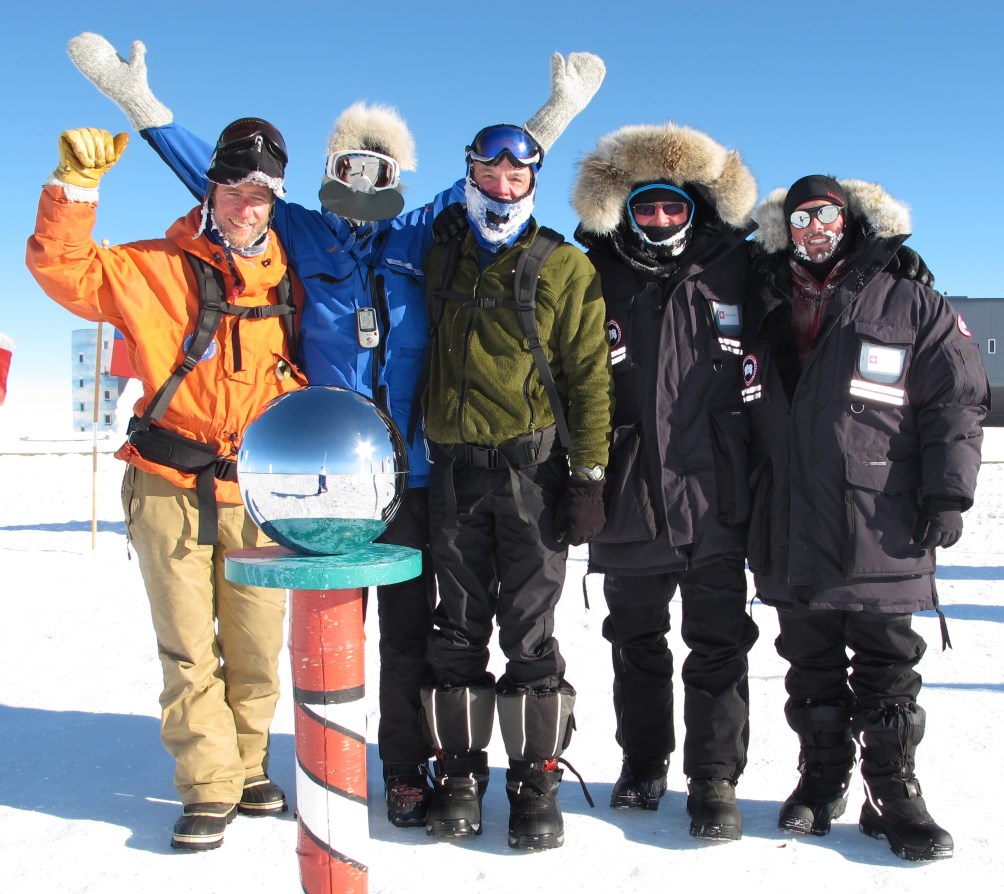
Meagan, the soloist, got here a day ahead of us and emerged from her tent to say hello. She is physically small and it seemed amazing that she had accomplished so big an adventure all on her own. (We later discovered that her resume is filled with equally impressive feats, including a summit of Everest.)
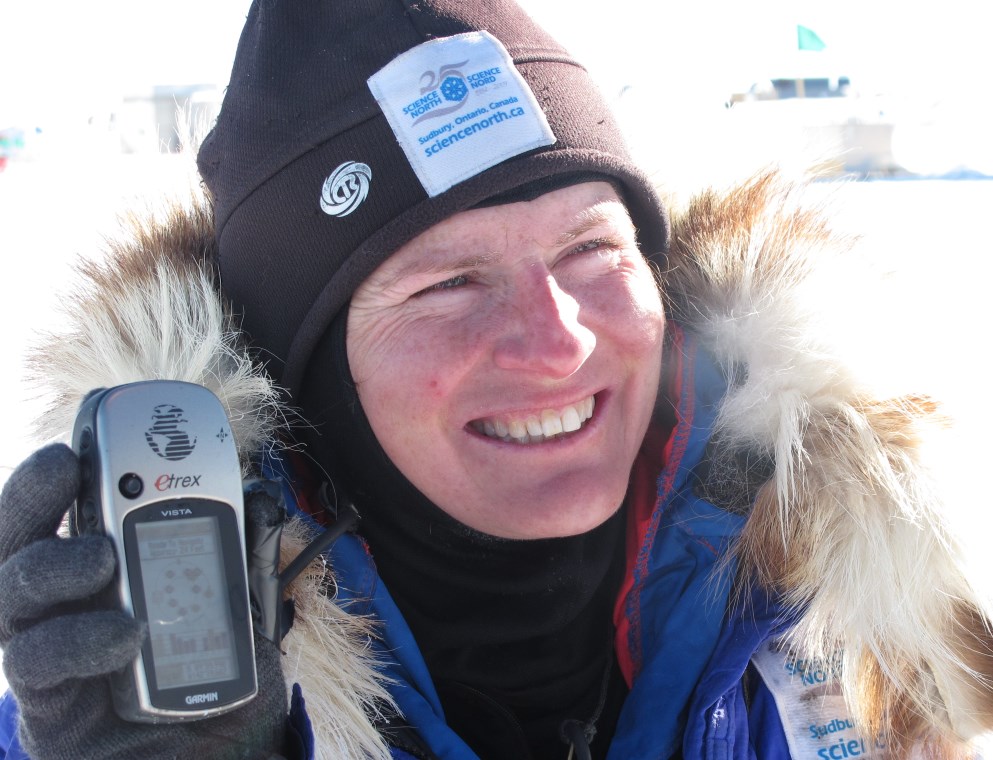
After the photo session we quickly got the tents up and Rob started brewing hot drinks. We spent a companionable couple of hours eating, drinking and savoring our success. ALE had thoughtfully supplied a cache of goodies for us and Gourmet Rob set to work providing us with indescribably delicious grilled cheese sandwiches, dripping in butter. What an incredible reward!
…Lars the YouTube star added another segment to his “Lars Around the World” video…great fun!
It is now 6 pm and we have just got back from filming the latest installment of the “Lars Around the World” YouTube video. Lars started this a few years ago and it has been a work-in-progress ever since. It is a simple idea that translates very effectively on camera: he stands in front of some famous landmark and someone off-camera tosses him a beach-ball which he catches and then lofts out-of-frame. He strings the clips together and you travel around the world with him catching and tossing the beach-ball all the way. It sounds silly but is actually very entertaining.
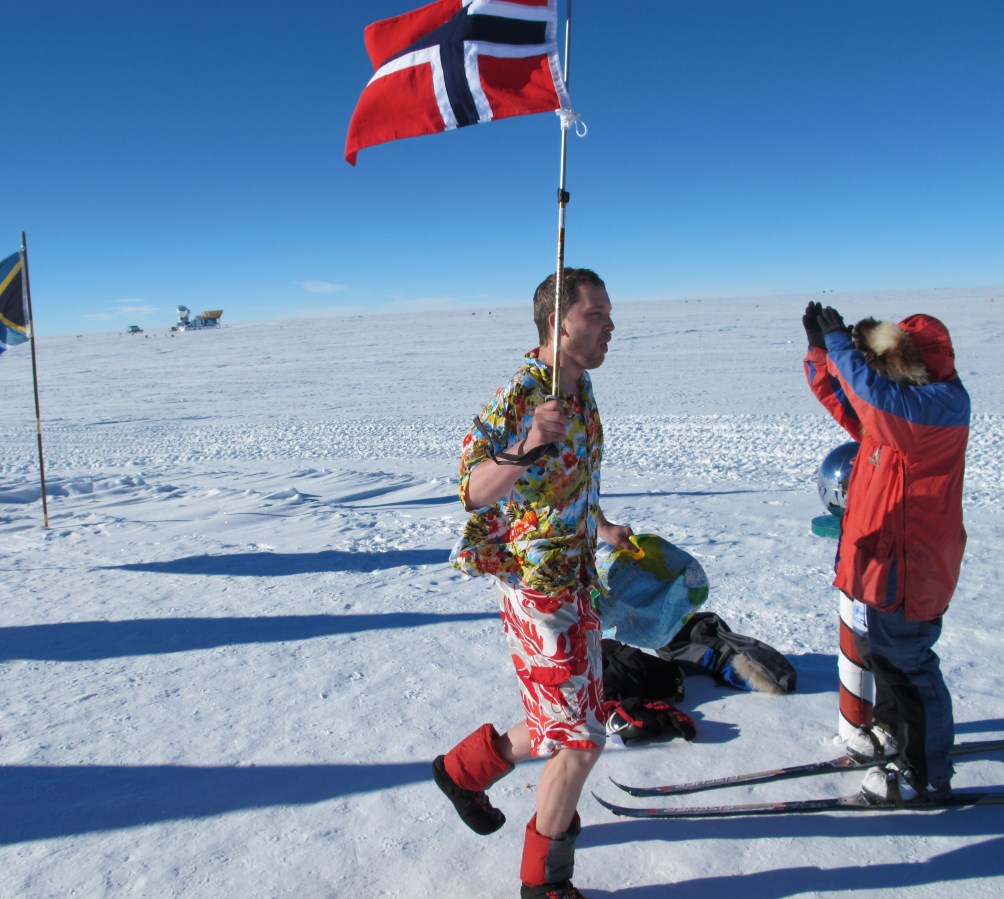
After the Pole catch-and-release I kept the camera rolling while Lars stripped down to shorts and a Hawaiian shirt and ran around carrying the Norwegian flag. A couple of minutes in shorts at minus 17°F are plenty for anyone and he soon made tracks for the tent and his waiting sleeping bag. All of this was fun and good excuse to leave the comforts of the tent for a little sightseeing. Meagan came out to enjoy the spectacle and seemed delighted to be back among the living again.
Everyone is going to join us in our tent for dinner tonight. Rob will officiate as head chef. The 8 pm dinner will give us plenty of time to prepare for our Station tour. The tour is now scheduled for 2 am. While this might be read as another example of the National Science Foundation’s well documented hostility (passive-aggressive!) towards visitors, it really isn’t. Two AM our time is 6 pm New Zealand time and it is only reasonable that Station time be used for scheduling visits.
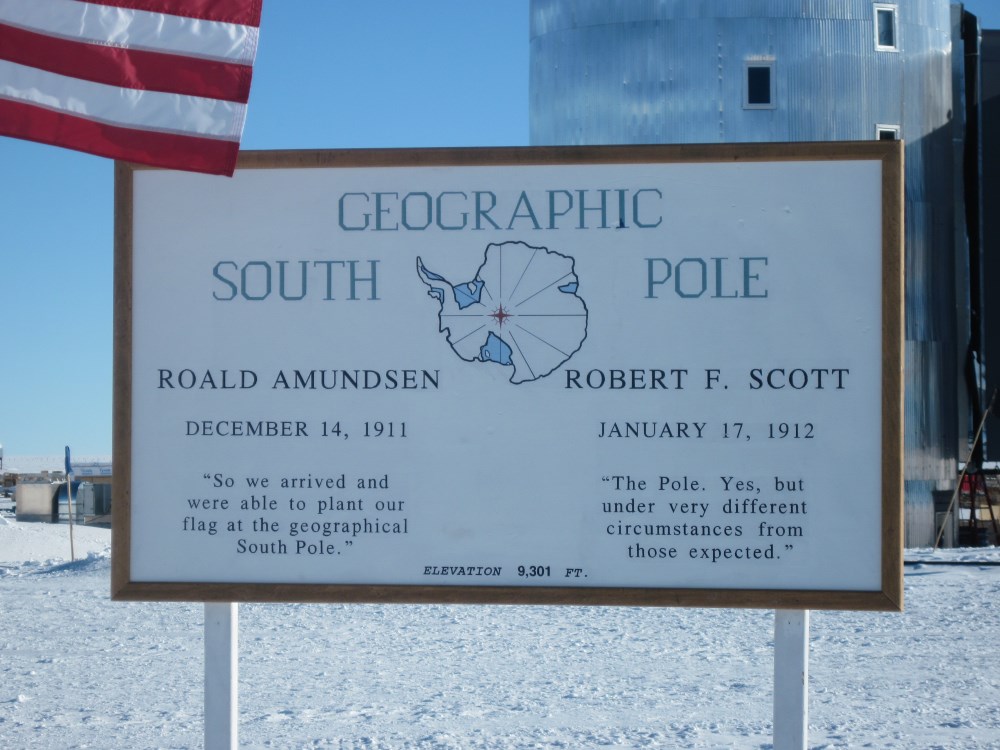
Sunday, January 17
It is now 4 am (our time) and we just got back from a ninety minute tour of the Station. I now feel that all of my trip goals have been realized and I’m absolutely thrilled about it.
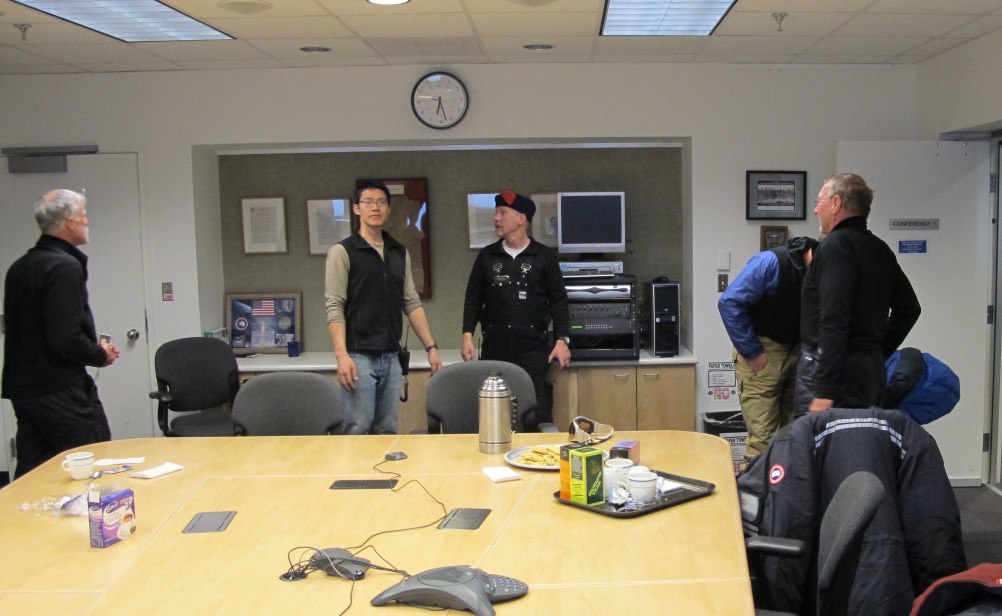
We met our tour guide, Hong, at Destination Alpha and he whisked us upstairs to a conference room for a Q&A session with himself and the Station Manager. The welcome was very hospitable; they even rolled out a tray of coffee and cookies for us. Both Hong and the Station Manager are Raytheon Polar Services Company employees. The Manager is a Raytheon veteran and Hong a new hire there for the adventure of overwintering at Pole. After the Manager left, Hong gave us to understand that he is massively overqualified for his job as chief electrician for the Station. This is entirely credible because competition for jobs at Pole is fierce. He arrived at Pole three months ago and is looking forward to the coming winter as a once-in-a-lifetime chance to do something virtually nobody gets to do. Good for him; he’s young (mid-20s) and seems genuinely enthusiastic about being here.
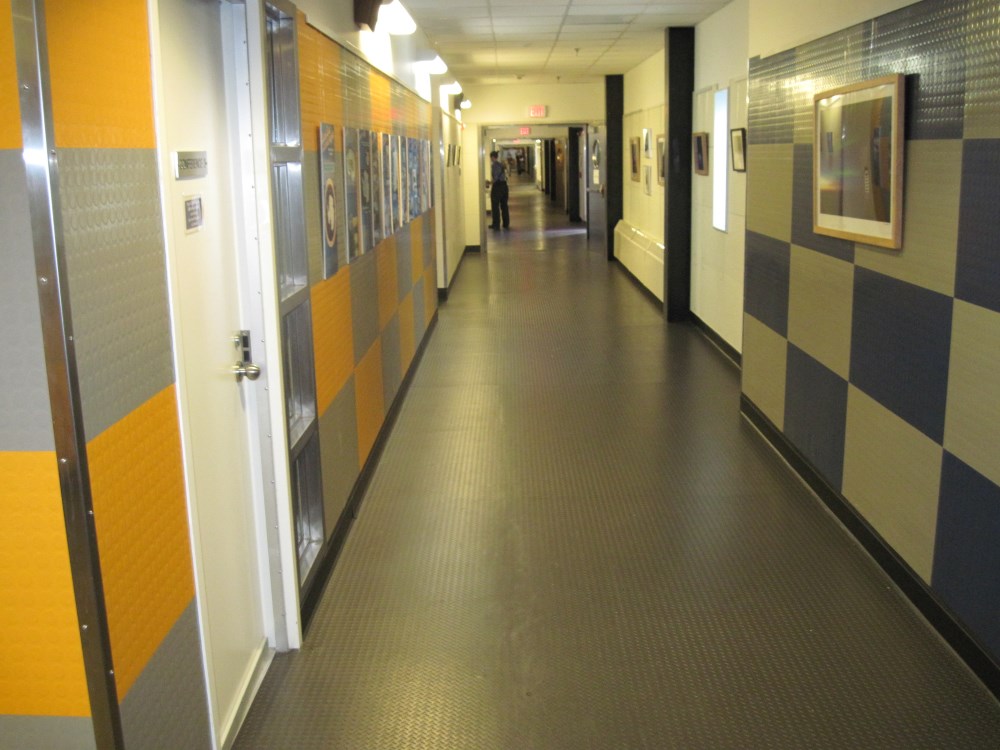
Hong conducted us through the communications office, dining facility, gym, weight room, hydroponics garden, various recreation rooms a few other nooks and crannies. Sadly, we did not get to see any of the accommodation units. The Station is filled to capacity and nobody wants a bunch of tourists poking through their rooms. Overall, the Station was pleasantly functional and comfortable in an overtly institutional way. It is easy to imagine the same interior in a high school in the middle of Kansas. After spending the last couple of weeks in tents it felt wonderful to be inside a real building with lights, rest rooms and central heat. The place is like a space station, providing warmth and sustenance in an otherwise uninhabitable place. According to Hong, it is notably energy-efficient as well. The whole thing operates on just one megawatt of power which is astonishing for a sixty-five thousand square foot building with one hundred fifty-two residents.
As expected, the personnel are overwhelmingly twenty-and-thirty-somethings. Not many greybeards seem to be around and there appears to be a heavy sports orientation to recreation time. A spirited game of volleyball was underway in the gym and the weight room was well supplied with treadmills and other exercise gear. It looked like a fun place to be and I envied the folks who get to call this place home for a season.
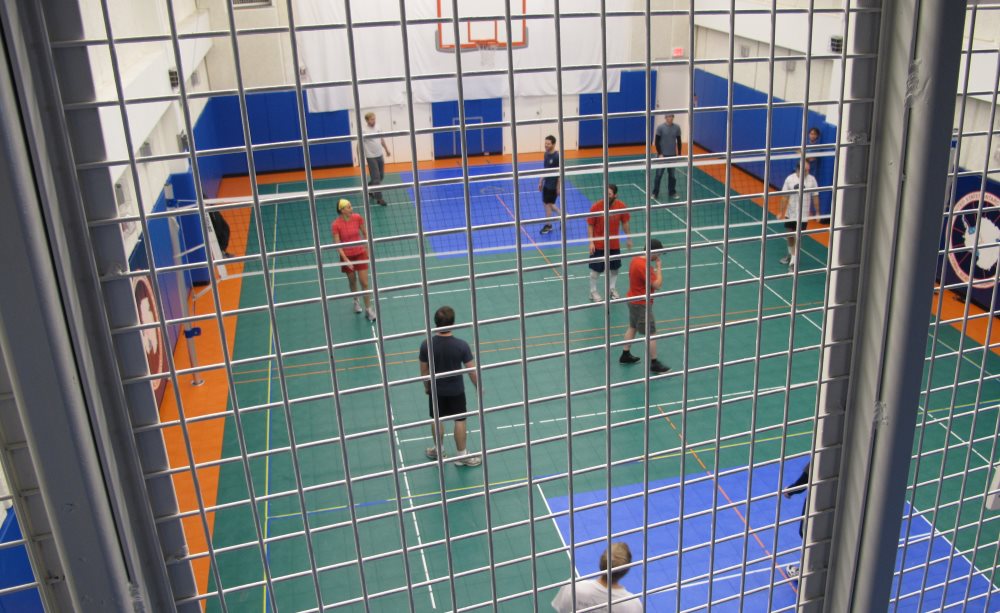
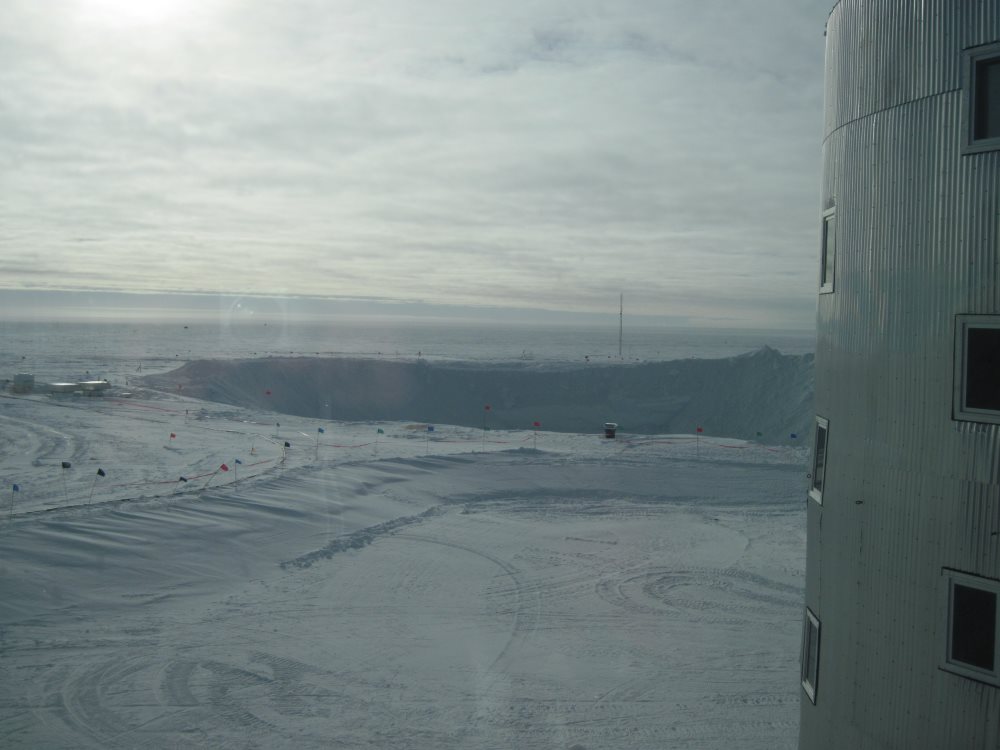
We, of course, paid a visit to the gift shop and all hands shopped with gusto. This late in the season (we were the last visitor group of the year), the inventory was a bit picked-over but that did not deter anyone from finding plenty of things to spend money on. The prices of things were amazingly modest. After paying a king’s ransom to get here it was good to know that you could pick up a nice tee shirt for only ten bucks. Rob told me that he could actually buy a Nalgene bottle cheaper here than in London. In the shop there was one area aimed mainly at visitors and another reserved for Station folks. The visitors’ side had the usual tee shirts, ball caps, sweatshirts, coffee mugs and other “South Pole Station” logo trinkets. The residents’ side was stocked to the gills with wine, liquor and DVDs with a few personal grooming items thrown in for good measure. Based on this, it appears that video-watching and wine-tasting play big parts in the leisure lives of Station staff. In any event, for all of us it was great to be able to leave the place with undeniable proof of having been to the South Pole. In an anteroom at the entrance to the gift shop there was an area where you could stamp postcards and passports with official-looking simulated visas and postmarks. Needless to say we all took advantage of this as well.

The visit went by in a flash. Before you knew it we were once again standing outside with visitation privileges officially rescinded. Now on the outside looking in, I noticed that the entrance doors to the Station were foot-thick stainless steel freezer doors. They would be at home in a supermarket meat locker anywhere in America. Quite sensibly, there were no locks on the doors.
…at South Pole Station there are no locks on the doors.
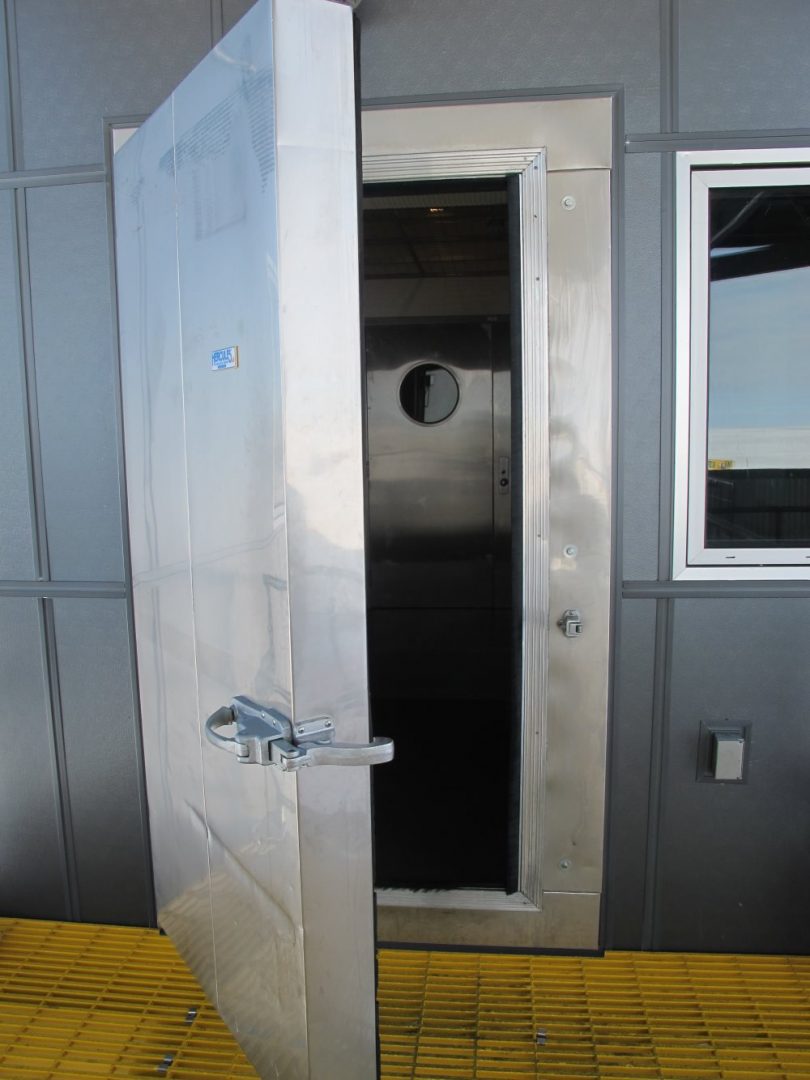
Prior to doing the tour, the crew plus Meagan gathered in our tent for a meal to celebrate our arrival at Pole. The food was great (Thanks, Rob!) and it was fun to hang out and chat. After sledging solo for forty days, Meagan seemed particularly hungry for conversation and was effervescent throughout. It turns out that she is a Major in the Canadian Air Force and is on a one-year leave without pay to pursue her climbing and adventuring dreams. She has completed the Seven Summits, sledged to the North Pole and will go to Nepal next. There she hopes to climb K2, Lhotse, Shishapangma, Broad Peak and Cho Oyu. She said that she loves expedition life and is happy to be without the comforts of home for months on end. She is plainly nuts.
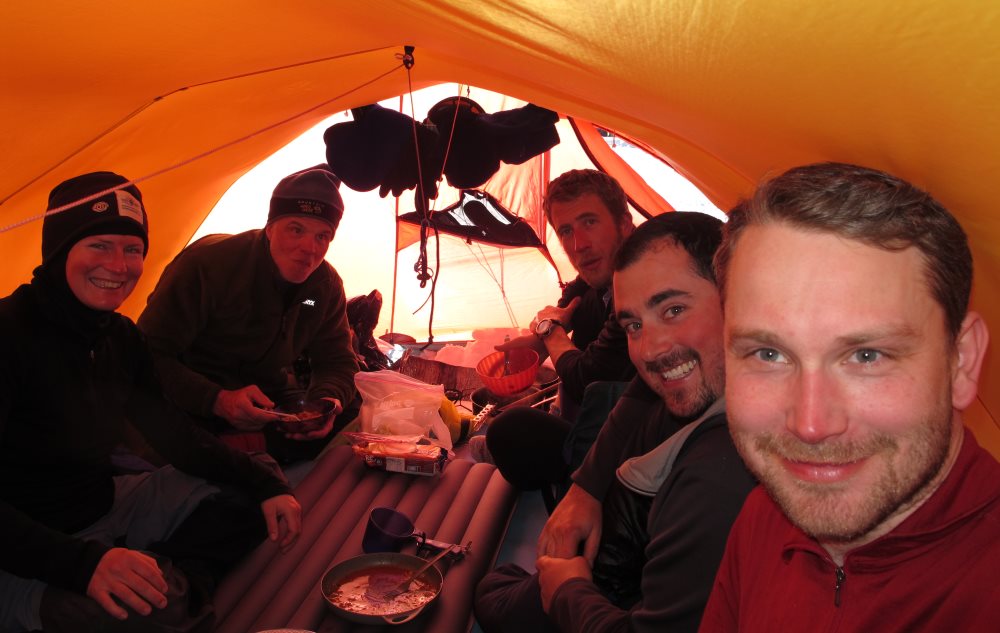
Dinner and conversation stretched over five hours and would have gone on forever but for the Station tour at 2 am. It is past 4 am now so I’m calling it a day. We will spend the little bit that’s left of the night here at Pole and look forward to the Basler’s arrival at 1 o’clock this afternoon, just nine short hours from now.
Sunday, January 17 (continued)
A lot has happened since my last entry in the wee hours of Sunday morning.
I woke up at 11 am to the sounds of Rob preparing brews. He reported that the Basler had launched from Patriot Hills and was expected at 2 pm. Hence, we immediately packed our gear, spent an hour or so taking down the latrine tent that was placed on site at the start of the season and hung loose in our now-empty tent until the plane arrived. When it did it taxied to within fifty yards of our camp and we piled everything aboard. It was absolutely freezing cold, at least minus 17°F. The Basler is a beautiful old thing and looked huge in comparison to the Otter that we came in on. The tail-dragger air frame says 1950 but the engines and propellers look up-to-the-minute modern. The way it effortlessly trundled over to us on its big skis was hugely impressive.
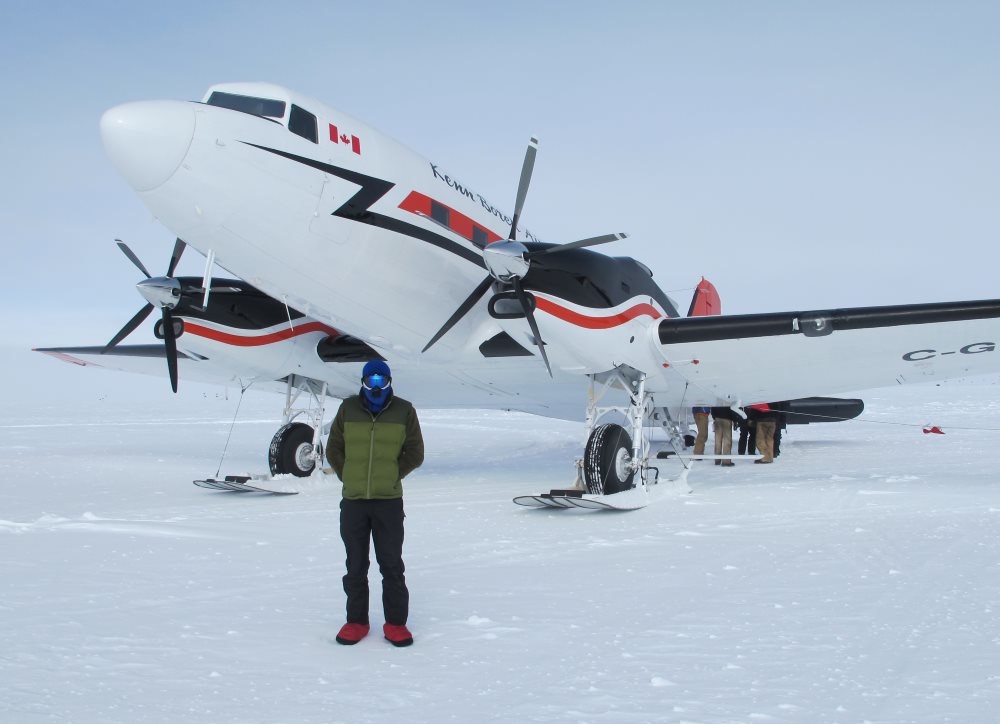
By a little after 3 pm we had the plane loaded and were able to board. It noisily taxied a couple of miles to the far end of the runway and took off, giving us a great parting view of the Station from a hundred feet in the air. Three and a half hours later we sighted the Patriot Hills. It was wonderful to see them from this high vantage point and remember our ski trek around them just ten days before. We bumped to the ground minutes later and were treated to a Sno-Cat ride to the dining tent where a champagne dinner awaited.
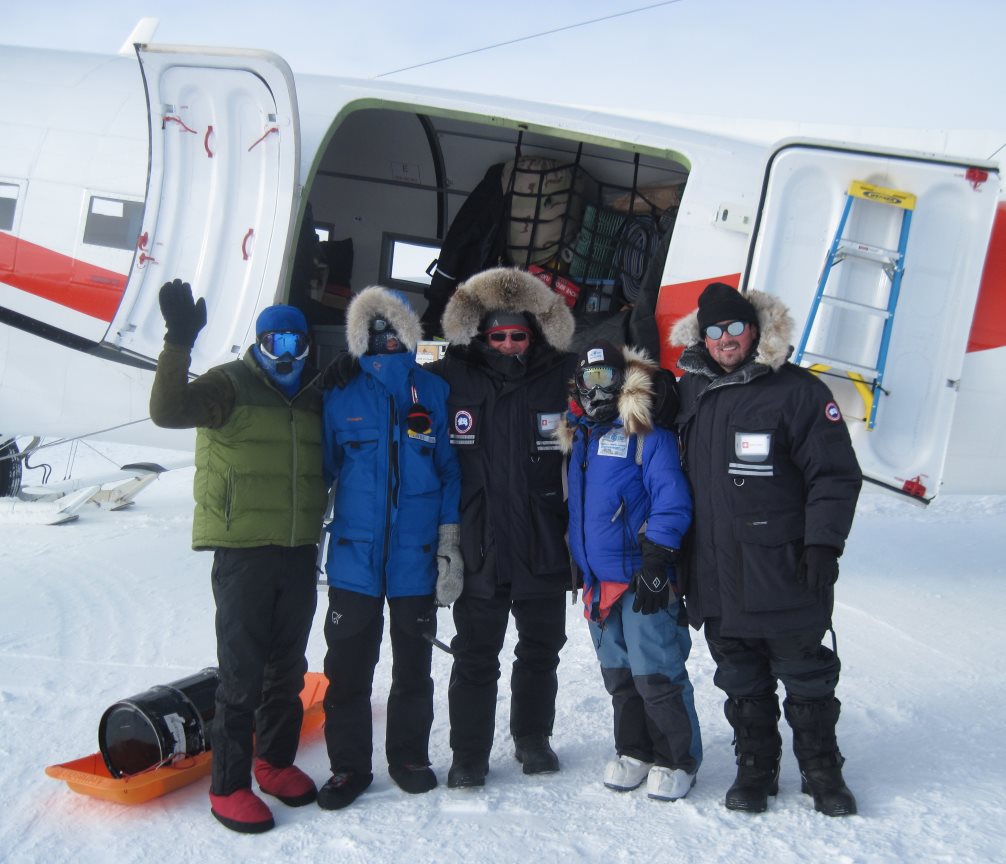
The dinner was great food and great fun. During it someone proposed a reunion trip next year to climb the Matterhorn. In our champagne-fueled enthusiasm this was an overwhelmingly popular suggestion. The dinner was a great end to a long and wonderfully eventful day. Kudos to ANI for treating us like the conquering heroes we doubtless are!
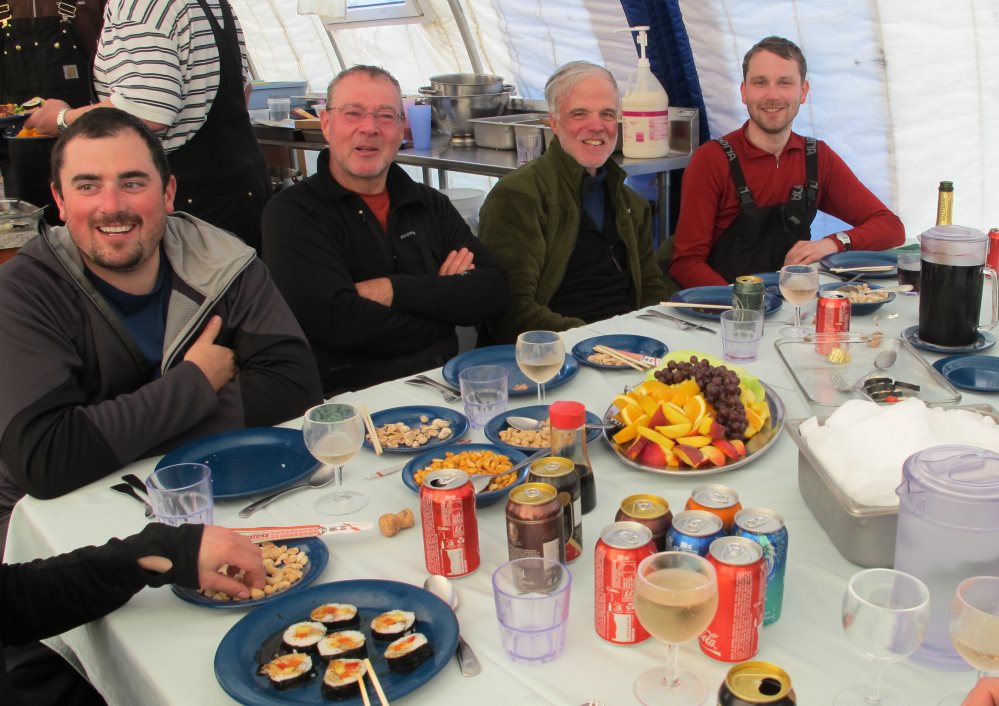
It is now 9:30 pm and we are ensconced in our luxurious clamshell tents. I am tremendously happy to be here and have the trek to Pole successfully behind me. Whatever the trip cost, there is no doubt it was worth every penny.
Monday, January 18
I slept late and barely made the 8:30 am breakfast call. Afterwards, I packed my gear and shaved a dozen days worth of stubble from my face, immediately eliminating my Papa Hemmingway look. It was wonderful to get out of my well-traveled garments and put on something fresh. Best of all, I was able to pack the dreadful Baffin boots and slip on my comfortable hiking shoes.
…mixed emotions about having to leave our cozy Patriot Hills base.
In mid-afternoon we were advised that the outlook for a flight out that evening was poor. The staff meteorologist briefed us and said that it was cold enough (too warm and the ice runway gets dangerously slippery) and clear enough (Visual Flight Rules apply) but the winds were too high. The winds must be below 18 mph for the Ilyushin to land. The meteorologist said that he would be monitoring the weather hourly and hoped that a window might develop in the evening. The bad news was that if the winds do not die down tonight we will probably be marooned here for a couple of days because a cloudy weather system is headed this way. We’ll see but, honestly, it won’t be much of a hardship to be stuck here for a spell. I remember one of the Pole-flyers swearing that he’d sell his right arm for a weather delay!
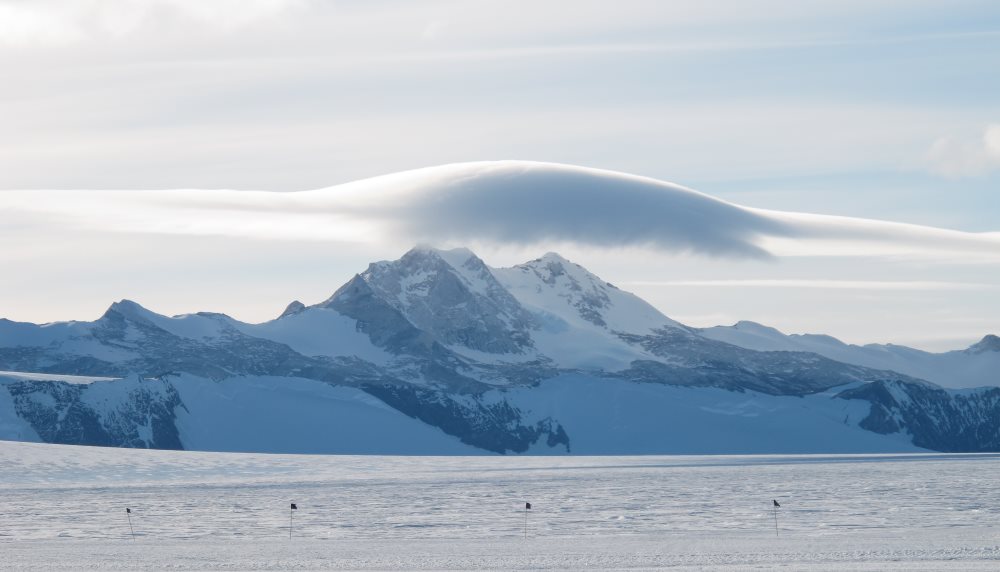
Astonishingly, at 5 pm, the base manager announced that the Ilyushin had launched from Punta Arenas and that we should immediately gather our bags for pick up. The hoped-for weather window had arrived right on cue. Four and a half hours later, someone announced that the plane was five minutes out so we all tumbled outside to see it land. As advertised, the Ilyushin hove into view and made a perfect landing on the ice. The noise of its reverse thrust braking echoed off the mountains and was loud to us a mile away. I was simultaneously thrilled and disappointed to see the plane on the ice. I couldn’t wait to get home but wanted to stay a little longer. Mixed feelings!
Turnaround time for the Ilyushin was two hours and by 11 pm we were walking down the ice to the runway. It was bitterly cold on that fifteen minute walk but the sight of the plane, our magic carpet back to the land of the living, made the trek wonderfully pleasant.
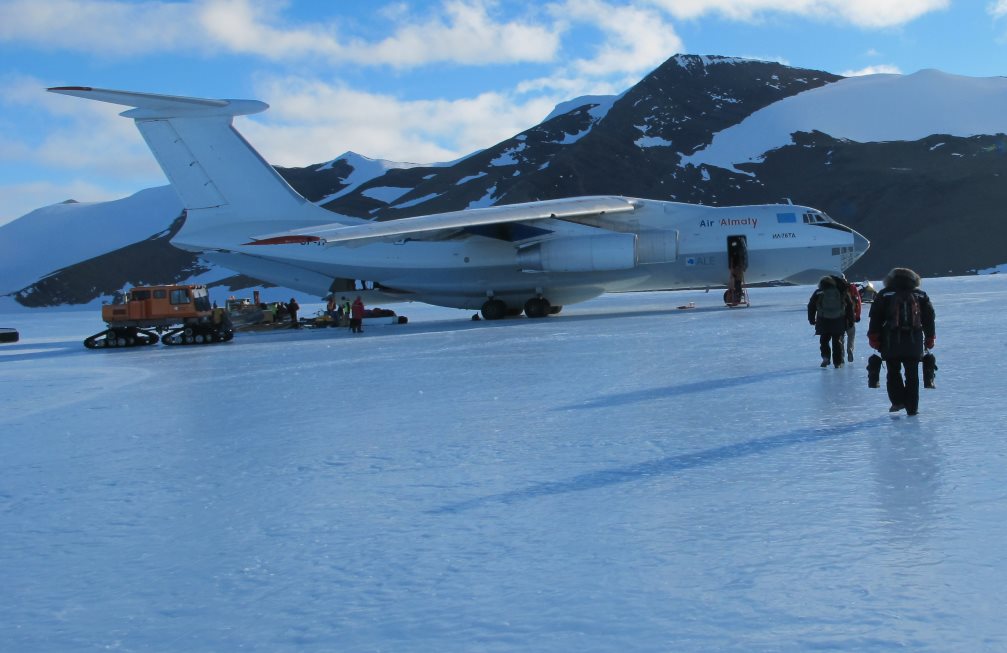
We took off at 11:30 pm and, bless the Russians, they heated the plane generously. I catnapped comfortably for much of the flight and halfway through was delighted to realize that it was dark outside.
Tuesday, January 19
The Ilyushin touched down in Punta Arenas at 4 am; we were picked up by the same big bus that brought us and by 4:30 am I was dropped off at my hotel. It felt surreal to be back at the place where the adventure started two weeks ago, now with the glow of accomplishment and all doubts settled.

While I thought for sure that I’d be hung up for a day or two in Punta, I walked down the block to the LAN office in good time for its opening at 9 am. Two hours later I emerged $900.00 lighter but with tickets for home. I stampeded back to the hotel at a full run, repacked my bags in a flash and mercilessly exhorted the taxi driver for speed; as a result, I made my 12:30 pm flight to Santiago with seconds to spare.
Wednesday, January 20
God bless LAN, they got us out of Santiago and into Miami in time to witness a beautiful sunrise. It was great to be back in the United States. After the quick two-hour hop to Houston, I was home and the trip officially over. It was wonderful to be home again.
Nonetheless, I’m already planning for my next trip. Naturally, it will be to the North Pole.
Photo Credits: many thanks to Lars, Rob and Patrick
